December 22nd, 2011
“In matters of principle, stand like a rock;
in matters of taste, swim with the current.”
.
~ Thomas Jefferson (1743-1826).
.
.

TASMANIAN FORESTS STATEMENT OF PRINCIPLES TO
LEAD TO AN AGREEMENT
7th October 2010
[Signed by all ten Parties on 14th October 2010]
.
“To resolve the conflict over forests in Tasmania, protect native forests, and develop a strong sustainable timber industry.”
.
.
The Parties to these Principles:
.
- Timber Communities Australia Ltd (TCA)
- The Construction, Forestry, Mining and Energy Union (CFMEU)
- The National Association of Forestry (NAFI)
- The Forest Industries Association of Tasmania (FIAT)
- The Australian Forest Contractor’s Association (AFCA)
- The Tasmanian Forest Contractors Association (TFCA)
- Environment Tasmania Inc. (ET)
- The Wilderness Society (TWS)
- Australian Conservation Foundation (ACF)
- Tasmanian Country Sawmiller’s Foundation (TCSF)
.
Note: Ratio of 7 to 3
.
.
‘Objectives‘ of the Parties
.
‘The parties to the Principles seek from State (Tasmanian) and Federal governments:
.
- Support for an delivery of all principles in full
- Interim support for the development of a plan to deliver the Principles, including:
- Verification (1) of Resource Constraints
- High Conservation Value Boundaries
- Implementation of the Principles through an agreed, fully-funded package and timeline that maximises benefits and reduces negative impacts
- Immediate interim assistance for Tasmanian harvest, haulage and silvicultural contractors
- To determine with industry, a guaranteed sustainable quantity and quality of wood supply within 3 months that is outside of the identified high conservation value forests, for the period of negotiations, in order to provide certainty for the industry, workers and communities.
- A progressive implementation of a moratorium on the logging of high conservation value forests commencing within 30 days – ensuring that priority, (i.e. those in the most advanced stages of planning for harvesting) HCV coupes identified by ENGO’s (2) are the first to be addressed. The full moratorium is to be completed within 3 months. Any necessity for any proposed variation to this due to unavoidable planning constraints has to be independently verified.
- To provide exit assistance for industry where required; and
- Not to accept new entrants into the Tasmanian industry, nor enter into new contractual relationships with the state while the negotiations are underway unless by the mutual agreement of all parties (3).
- Accept that delivery of these Principles will require joint agreement of the parties to timelines and funding.
- To develop an agreed stakeholder-led implementation process with a finalised full agreement within 12 months.
.
– – – – – – – – – – – –
Notes:
.
(1) Draft verification process document under construction.
(2) ENGO’s in this document means those environmental non-government organisations who are parties to this document (i.e. ONLY Environment Tasmania, The Wilderness Society, and the Australian Conservation Foundation)
(3) No party shall be required to accept a Principle which would otherwise apply to it where to do so would cause a breach of an existing contract or statutory obligation.
.
.
The Principles
.
The parties agree to the following:
.
General Wood Supply
Provide a sustainable resource supply profile to industry based on an agreed minimum quantity and quality requirement for industry. This will be underpinned by legislation.
.
Native Forest Wood Supply
Subject to the provisions of the transition, as legislated Native Forest entitlements are handed back, ensure these entitlements will not be allocated nor licensed to new players.
.
HCV Forests
Immediately protect, maintain and enhance High Conservation Value Forests identified by ENGO’s on public land.
.
Transition
Transition the commodity (non specialty) forest industry out of public native forests into suitable plantations through a negotiated plan and timeline.
.
Industry
Create a strong sustainable timber industry including the development of a range of plantation based timber processing facilities including a pulp mill. There will need to be stakeholder consultation and engagement with the proponent, ENGO’s and the community.
.
Specialty Timbers
Provide for ongoing speciality timber supply including Eucalypt for our Tasmanian high value furniture and craft industries through a negotiated plan and timeline.
.
Plantations
Support sustainable and socially acceptable plantations including agreed reforms and new agro-forestry outcomes, including pursuing certification.
.
Private Forests
Encourage and support, but not mandate, private forest owners to: seek assistance for certification; and protect, maintain and enhance high conservation value forests on their properties.
.
Communities Impacted
Support impacted rural and regional communities, workers, contractors and businesses, through a range of economic development, financial assistance, compensation and retraining measures.
.
Community Engagement
Engage and involve the broad Tasmanian community in the development and implementation of a durable solution to the Tasmanian forest conflict.
.
Tourism
Develop Tasmania’s nature based tourism industry in line with these Principles.
.
Planning
Develop a fully funded, independent, scientifically led landscape conservation, restoration and integrated catchment management program, and associated governance and regulatory improvements.
.
Government
Reform and support government agencies, policies and legislation as necessary for the implementation of an agreement associated with these Principles.
.
Climate Change
Seek funding for improving carbon outcomes as a result of delivering these Principles.
.
Biomass
In Tasmania, only permit plantation forest processing and plantation harvesting residues to be used as biomass for Renewable Energy Certificates.
.
Certification
Encourage Forestry Tasmania to firstly obtain Controlled Wood accreditation on delivery of the moratorium, secondly, obtain full FSC certification on resolution of an FSC National Standard and once an agreement based on these Principles has been finalised.
.
Durability
Undertake to ensure all elements of this agreement are fulfilled on a durable basis.
.
Legislation
Require State and Federal legislation to implement agreed outcomes arising from these Principles including appropriate review mechanisms, milestones and sanctions.
.
.
Editor’s Comment:
.
The above Statement of Principles was reproduced manually due to restricted access of the official PDF document as provided on the Tasmanian Premier’s official website. The security lock down denied printing and copying.
But then as Tasmanian Labor Premier Lara Giddings studied Law, perhaps there was a legal reason for her deliberate restriction of the details to the Tasmanian public.
.
This is the Tasmanian Premier’s restricted document:
.
>Tasmanian Forests Statement of Principles (2011)
.
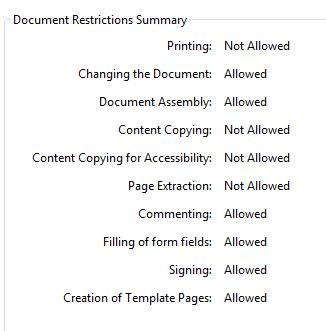
.
Note: Red highlighted text indicates actual shortcomings in the document or process to date.
Note: Green highlighted text indicates particular environmental emphasis.
.
Tags: Community Engagement, Forestry Transition, FSC certification, FSC National Standard, General Wood Supply, HCV Forests, high conservation value forests, IGA, Intergovernmental Agreement, Native Forest Wood Supply, Parties to the Principles, Private Forests, Specialty Timbers, Statement of Principles, Tasmanian Forests Statement of Principles
Posted in 47 Land Reform Initiatives!, Tasmania (AU), Threats from Deforestation, Threats to Wild Tasmania | No Comments »
Add this post to Del.icio.us - Digg
Leave a Reply
You must be logged in to post a comment.
December 22nd, 2011
This article was initially published by Tigerquoll on Candobetter.net on 20090625 under the title ‘Shooters Party – fanatical red necks pushing for open season in National Parks’.
.
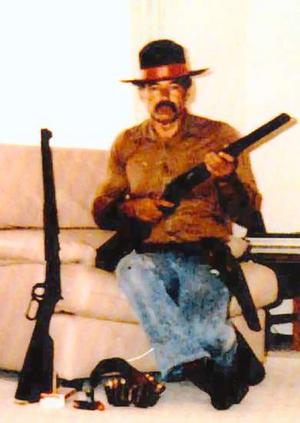 An infamous licensed shooter
An infamous licensed shooter
.
Since May 2009, Robert Brown MP of the Shooters Party has been pushing for the Game and Feral Animal Control Amendment Bill 2009 to be passed into legislation in New South Wales, Australia. The spin of this Bill is so feral animals can be controlled in National Parks. But in reality the proposed changes would mean the following main changes:
.
- Many of Australia’s native fauna across NSW would be condemned as ‘game animals’ just like in colonial times, when Australian native animals were despised as ‘vermin’. Other native animals can be included in the shooters hit list so long as there is consultation with the Minister for National Parks (DECC).
- It would be lawful for sporting shooters to hunt and shoot native fauna in all National Parks, State Forests, Crown Land and ‘private game reserves’ across NSW. Killing wildlife is to be branded as ‘conservation hunting’ and basically would be permissible through most natural landscapes outside built up areas.
- The Game Council of NSW, which is a government body dominated by members of shooting and hunting clubs, and it would assume authority for granting shooting licences in National Parks.
- Shooters and hunters in National Parks would be immune from protesters trying to protect native animals and birds – as it would become “an offence to approach persons (within 10 metres) who are lawfully hunting on declared public hunting land, or to interfere with persons lawfully hunting game animals”.
- Any environmental protection legislation that impedes shooting and hunting of native animals is to be overriden by the new changes – such as under the National Parks and Wildlife Act 1974.
- Hunting of native game animals can be done by non-commercial shooters – i.e weekend sports shooters. Using spot lights is optional and it is ok to leave the dead, dying and injured prey where they fall.
- In the case of native waterfowl, licensed game hunters will be required to pass an official identification test of native waterfowl. The record of shooters killing protected bird species is woeful, yet the proposed legislation won’t make any difference.
.
(Source: New South Wales Legislative Council, Game and Feral Animal Control Amendment Bill 2009, Second Reading in Parliament)
.
Professional safari hunters, recreational hunters, sports shooters, or weekend warriors?
.
This Bill would overturn all environmental legislation protecting our remaining wildlife in NSW. It is repugnant. This proposal is nothing to do with noble gesture of taking on the task of the government’s culling feral animals in National Parks.
.
The Game Council in this self-interested set of demands, simply wants to give its weekend warrior member base open slather access to shoot almost anything and everything in the bush. It would be 24/7 open season on wildlife perpetually across NSW every day of the year. Every weekend would be weekend warrior party time in the ute with the spotties and the beers and the guns – just like in the good old days eh? In doing so, The Game Council and the Shooters Party have shown their true colours. The Game Council’s objective is to provide for the effective management of ‘introduced species’ of game animals. By advocating the hunting and shooting of native animals and birds is outside its ‘introduced species’ charter.
.
According to Greens MP Ian Cohen, if feral animals are to be culled then:
“it should be managed by trained Livestock Health and Protection Authority officers.” “Recreational hunters are not helping when it comes to feral species – the reality is that hunters, with their dogs, are often a cause of pest species dispersal, driving feral animals into national parks.”
.
Fortunately, NSW Cabinet yesterday backed away from supporting the Bill.
‘Ivan Milat was a licensed competition shooter. In police interviews he referred to a shooting range in the Belangalo State Forest he knew well.‘
.
(Source: ^http://www.abc.net.au/austory/content/2004/s1239470.htm)
.
Milat was probably a member of a local shooting club, perhaps the Bowral Pistol Club situated in the Belangalo State Forest or with the Southern Highlands Rifle Club. As such, Milat would have been eligible to have been one of the licensed shooters/hunters under this Bill before being convicted of his crimes. This example of a licensed competition shooter does not engender public confidence in the shooting and hunting fraternity to be trusted to self-regulate itself and attract law abiding citizens and carte blache access to National Parks for shooting!
Message:
Exclude all native animals as ‘game’ and prohibit the use of dogs in all hunting and shooting and you will have me starting to listen to proposals by The Shooters Party to control feral animals. But as for controlling feral animals in National Parks in NSW, this is an ecological management matter for DECC to be held accountable for.
To be genuine about feral control, this Bill must specifically exclude:
- Native animals
- National Parks
- Recreational shooters
.
The intent then of The Shooters Party to help control ferals will starts becoming more genuine.
- If the Bill is one of targeting ferals, why does it include native animals in National Parks?
- If the Bill is one of targeting ferals, why is it limited to shooting and not other control means?
- Why are the government authorities most qualified to control feral animals not granted the delegated responsibility for this Bill?
- Where in this Bill does it specify controls on the time of day that shooting can take place? (i.e. it is 24/7)
- Where in this Bill does it specify how shooting is to be independently policed? It doesn’t.
- Where in this Bill does it specify that only qualified marksman trained in species identification will be permitted to engage in feral hunting in national parks? Why are recreational hunters permitted without the high standards of marksmanship and species recognition training?
- Where in the Bill are inexperienced recreational hunters prohibited from such shooting? These are the ‘weekend warriors’ that give the contract professionals a bad name, yet the The Game Council is not going out of its way to distinguish these two extremes.
- Who will be monitor, police and breath test the shooters?
- Who will watchdog those monitoring the shooters to ensure that all legal, environmental and ethical standards are properly complied with?
.
Under The (NSW) Fireams Act 1996 Part 2, Division 1, Clause 10 ‘Applications for Licences, all that is required to be granted a firearms licence is:
- Be over 18
- Show proof of ID
- Be someone who has not been convicted of an offence within the past 10 years
- Not subject to an apprehended violence order
- Not subject to a good behaviour bond
- Not deemed not a risk to public safety
- Pay the license fee.
.
Convicted backbacker murderer, Ivan Milat, was a legally licenced shooter and got through these stringent ‘elite’ tests and he owned multiple longarm firearms.
How does this reflect upon the test standards for firearm owners?
Since 18 August 2008, the Firearms Amendment Act 2008 has required unlicenced persons seeking a licence for longarms undertake and pass an approved Firearms Safety Qualification (Long-arms) Course. This is admittedly a step in the right direction.
.
(Source: NSW Shooting Centre)
.
Lack of professional controls for shooters
.
Under Firearms Regulation 2006 (NSW) clause 28 ‘Recreational hunting/vermin control—persons who are not members of approved hunting clubs’, an applicant can obtain a firearm licence without being a member of an approved hunting club in order to engage in recreational hunting/vermin control so long as they obtain and hold written proof of permission to shoot on rural land by the landholder which must describe the land to which the permission relates and the type of game to be shot.
But there is nothing in the legislation to enable a firearm holder to have a licence suspended or revoked as a result of shooting protected wildlife.
The NSW Department of Environment and Conservation, not the Game Council should be the prescribed authority for all vertebrate pest animal control.
.
Poor Species identification training
.
It is quite obvious that a feral animal is not synonymous with a native animal. One would hope that a shooter can distinguish a rabbit from a wombat, but what training exists to ensure natives are not mistakenly shot. Where is the policing to ensure that natives are not shot intentionally?
.
‘Conservation Hunters’?
.
Surely, this conjured term is oxymoronic spin. Instead, the designation ‘professional contract shooter‘ needs to be distinguished from ‘recreational shooter‘. If this Bill is to genuinely seek a professional approach to feral animal control it must specifically exclude recreational shooters and the weekend warrior element.
.
‘Ancestral & cultural right to hunt’?
.
The loose premise of some “ancestral & cultural right to hunt” – may apply to traditional Aborigines using traditional methods on traditional lands away from populated areas, but to quote the Game Council’s NSW Hunter eduication Handbook.. “in today’s world, hunting is no longer a necessity for most of us, but is something we are never the less driven to the associations with our past.” (p4.1.5). So this rather dubious argument says hunting is justified by some nostalgic notion of being connected to early colonists.
Airguns to teens are a catalysts for psychopaths. The book ‘Sins of the Brother: The Definitive Story of Ivan Milat and the Backpacker Murders‘ is an eye opener into a case of a hard rural lifestyle controlled by hardline paternal corporal punishment, when guns are part of life and temper tolerated.
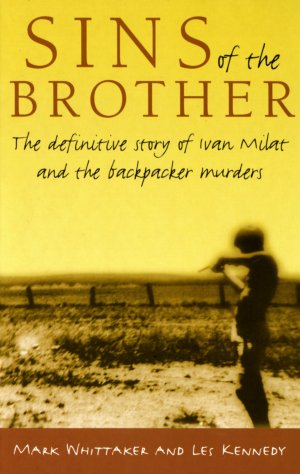 Publisher: ^http://www.panmacmillan.com.au/ Publisher: ^http://www.panmacmillan.com.au/
.
“Guns are power” as confirmed by Ivan Milat’s brother Boris. Untempered power leads to consequences only limited to the discretion of the person in control.
Gun laws in Australia fuel criminal opportunity, yet gun laws don’t test for criminality. A cocktail of a gun acceptance culture, killing of animals from an early age, an insular rural upbringing, a penchant for control, an uncontrolled aggression, and opportunity are a recipe for incubating deviancy and how Ivan Milats and Martin Bryants are made. Milat’s upbringing featured a tolerance of incest, which fueled sexual depravity.
.
It starts with children being given airguns (or similar). Airguns inculcate shooting living things as acceptable.
.
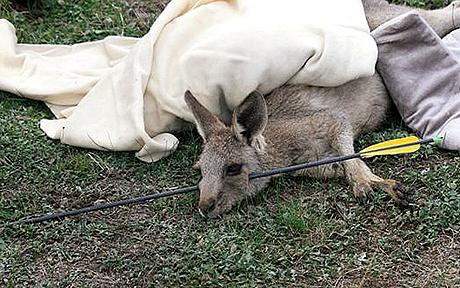 Kangaroo survives arrow shot through head Kangaroo survives arrow shot through head
Melbourne (2009):
‘A kangaroo survived for about a week after being shot through the head with an arrow, wildlife officials said, and is expected to make a full recovery. Wildlife Australia has posted a A$10,000 dollar (£5,032) reward to find the person responsible for shooting the kangaroo, which was found in parkland near Melbourne’s outer suburbs on Thursday.
Veterinary surgeons from Melbourne Zoo operated on the stricken animal over the weekend and were optimistic about his chances.
“This was a big injury, but because the arrow didn’t seem to have been in there for a long time, and the injury was fresh, hopefully he’ll be okay,” said Michael Lynch, a vet at Melbourne Zoo.
“I’m cautiously optimistic about the kangaroo’s prospects for a full recovery.”
The marsupial was rescued just days after another kangaroo was found with an arrow in its rump in the same location, said Fiona Corke, a Wildlife Victoria spokesman. She said her organisation wanted to catch those responsible.
“It’s just unbelievable, I just can’t believe that anybody would do something so cruel. It must be a very cold-hearted person to do that,” she told national news agency AAP.
Miss Corke said the kangaroo was believed to have survived for up to a week before it was discovered and taken to an animal hospital.
.
(Source: ‘Kangaroo survives arrow shot through head‘, Telegraph (UK), 20090511, ^http://www.telegraph.co.uk/news/worldnews/australiaandthepacific/australia/5309242/Kangaroo-survives-arrow-shot-through-head.html)
Tags: air gun, air rifle, animal cruelty, bb gun, hillbilly, Ivan Milat, kangaroo poaching, Martin Bryant, pellet gun, Shooters Party, slug gun, Wildlife
Posted in Kangaroos and Macropods, Threats from Poaching and Poisoning | 1 Comment »
Add this post to Del.icio.us - Digg
Leave a Reply
You must be logged in to post a comment.
December 21st, 2011
There is a ‘baby boomer‘ political penchant to encourage more and more freight to travel by truck, which has dominated Australian Government transport planning for the past sixty years since World War II.
It is a short-term tactical stop-gap measure. Compared with rail freight, road linehaul for large volumes, over long distances, in the long term is price uncompetitive, and Peak Oil driving up fuel costs will eventually prove road linehaul a strategic economic blunder.
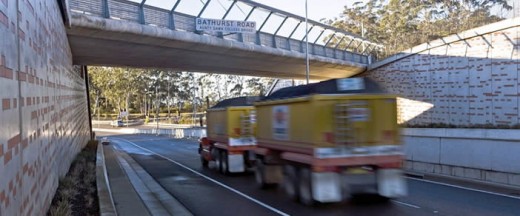 Speeding B-doubles increasingly dominate the highway over the Blue Mountains
‘Woe betide anyone who gets in my way!‘
(Photo by Editor, free in public domain) Speeding B-doubles increasingly dominate the highway over the Blue Mountains
‘Woe betide anyone who gets in my way!‘
(Photo by Editor, free in public domain)
.
Yet ‘road-centric’ freight policy dominates the infrastructure planning, simply because it is being driven by the self-centred vested interests of the trucking industry – influenced (read ‘bought‘) by ongoing substantial monetary donations (read ‘bribes’) to the electoral campaigns of alternating Labor and Liberal governments. Visit ^http://democracy4sale.org/ and choose either:
.
Money talks, hence the political penchant to favour road freight. Whereas rail, entrenched as a government monopoly, has long denied any community say. Rail has become the Cinderella to Road where only a small honourary volunteer lobby, the Australasian Railway Association (ARA) has not the funds to compete against the collective corporate might of trucking donors. Read about the ARA: ^http://www.ara.net.au/site/index.php
The Liberal-Labor Party’s Auslink National Transport Plan since 2004 professed ‘a new strategic framework for the planning and funding of Australia’s roads and railways to meet long term economic and social needs.’ However, in reality the funding has all but gone into building bigger and more highways.
News is, we are about to enter the year 2012, so we should have advanced somewhat from post-war trucking thinking.
Yet in the Blue Mountains, west of Sydney, well over $1 billion is forecast to be spent to build a massive highway viaduct and tunnel; simply so that larger and faster trucks can cart freight, fuel and ore over the Blue Mountains and to bypass the village of Mount Victoria. The fact that a rail line following a similar route exists and has long been used to cart copious quantities of coal over the Blue Mountains, is ignored by a truck-centric political mindset. The planned Mount Victoria bypass is just one of the multiple ongoing highway widening sections being constructed by Roads and Traffic Authority (RTA) contractors over the Blue Mountains and ultimately extending from Penrith in Sydney’s outer metropolitan west to the New South Wales central-west regional town of Orange, 250km away.
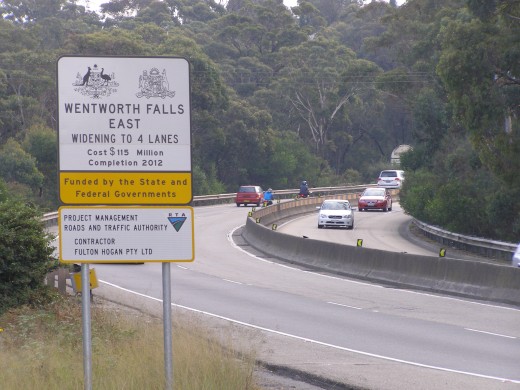 Great Western Highway, Wentworth Falls, March 2010
This trucking section just $115,000,000 (pre-blowout estimate)
(Photo by Editor, free in public domain)
Great Western Highway, Wentworth Falls, March 2010
This trucking section just $115,000,000 (pre-blowout estimate)
(Photo by Editor, free in public domain)
.
The widening of the highway has caused the destruction of much native vegetation and has ruined the bushland amenity of the villages and towns of the Central Blue Mountains. Construction has caused irreversible sediment contamination of many Blue Mountains waterways that drain from the highway ridgeline downstream into the Blue Mountains National Park and World Heritage Area.
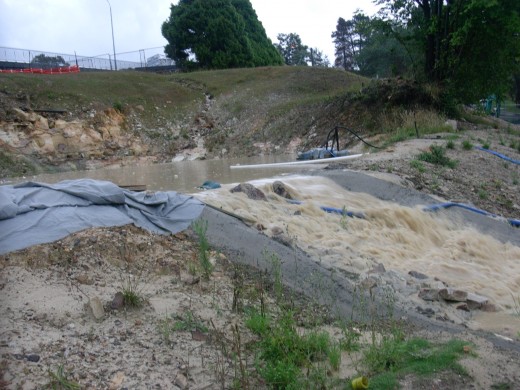 Leura, January 2006
– collateral stormwater pollution of downstream creeks to serve the Trucking Expressway
(Photo by Editor, free in public domain, click photo to enlarge) Leura, January 2006
– collateral stormwater pollution of downstream creeks to serve the Trucking Expressway
(Photo by Editor, free in public domain, click photo to enlarge)
.
Since 1996, the widening of the Great Western Highway over the Blue Mountains has cost over a billion dollars already. Yet the highway runs parallel to an existing dual rail line, which for the most part runs right alongside one another. One justification argued for the massive cost and widening of the highway is to relieve traffic congestion for motorists, but there is a low population base in the Blue Mountains as settlement is confined to the ridgeline over the Blue Mountains where the highway and rail run together. Steep terrain either side prevent a large population expansion.
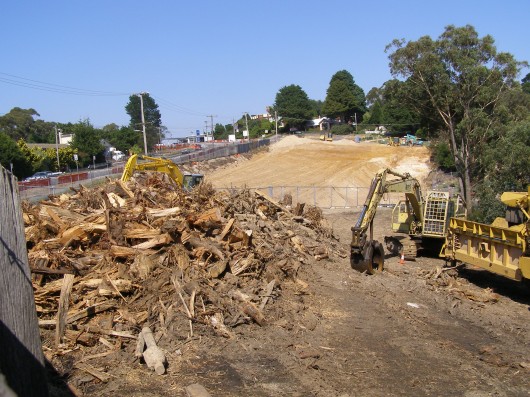 Katoomba, May 2009
– collateral vegetation damage to serve the Trucking Expressway
(Photo by Editor, free in public domain, click photo to enlarge) Katoomba, May 2009
– collateral vegetation damage to serve the Trucking Expressway
(Photo by Editor, free in public domain, click photo to enlarge)
.
Before construction began, the only systemic traffic congestion on the highway was at weekends when tourists from Sydney ventured west in their cars. Spending billions to encourage domestic regional tourism has not been the real justification. The real justification has been and continues to be to encourage more truck freight along the Great Western Highway.
Yet the public is still waiting for a cost-benefit analysis, a calculation of any return on investment, an end-to-end journey analysis of the freight options, an holistic comparison to rail.
Instead, not only has there been a road-only freight focus, the trucks have got bigger. Governments are now permitting and encouraging the use of 19 metre ‘B-doubles’ along the highway. It is only a matter of time before 26 metre B-doubles turn up. In Victoria they are permitting B-triples – basically road-trains! Successive Labor and Liberal governments at both national and state level have maintained a truck-centric mindset since the 1980s when the NSW Greiner Government abandoned and close down much of the State’s rail infrastructure, including the closure of rail depots at Valley Heights and Junee.
This baby boomer political penchant has been encouraged and lauded by baby boomer himself, Bob Debus, long-time Labor politician for the NSW seat of Blue Mountains then the Federal seat of Macquarie, both covering the Blue Mountains region. Bob Debus has since retired, yet the Labor boomer mindset perpetuates with its truck-centric fervour.
.
“It is with dismay that I watch the Mountains stand by as the RTA fulfills Bob Debus’ promise of an “upgraded” highway (read Trucking Expressway) – by his own admission – built to carry 26m B-double trucks. The RTA admits that when the western container hubs are finished they will generate 4000 extra B-double movements per day. Parked end to end they would stretch 102 km – every day! Goondiwindi, Toowoomba and many other towns don’t allow them but we will see them roaring through every Mountains town – past schools, shops and homes.”
.
~ Dennis Plink, Hartley Vale (letter ‘B-double agenda‘ in Blue Mountains Gazette, 20090304, p.8.
.
The widening of the highway into a trucking expressway is wrecking the Blue Mountains. And certainly, those trucks have increased – in number, in size and length and in speed. These bigger, faster trucks are not policed. They are turning the Great Western Highway into a dangerous death zone.
 Speeding B-Double truck overturns on Lapstone Hill
– at an already widened section of the Trucking Expressway
Zoom, zoom, zoom!
(Photo by Top Notch Video). Speeding B-Double truck overturns on Lapstone Hill
– at an already widened section of the Trucking Expressway
Zoom, zoom, zoom!
(Photo by Top Notch Video).
Last July, on the highway at Lawson near Queens Road, truck driven by a 66-year-old Murrangaroo man collided head-on with an eastbound car trapped a female passenger, followed by a separate collision between a truck and a car near Boland Ave at Springwood. On Friday, 29th July 2011 on Lapstone Hill the driver of a semi-trailer failed to negotiate a left-hand bend while travelling east and crashed into the concrete median barrier. The impact caused the truck’s trailer — containing a full load of bark — to tip over the barrier and slide a short distance into the path of a westbound Mitsubishi Lancer, driven by a 30-year-old Hazelbrook woman, who remained trapped before being rushed to Westmead Hospital. Traffic chaos ensued as all westbound lanes were closed for more than eight hours and one eastbound lane also shut for the clean-up operation. Lapstone Hill is one of the widened sections of the highway.
.
[Source: ‘Blue Mountains highway mayhem’, by Shane Desiatnik, Blue Mountains Gazette, 20110803, ^http://www.bluemountainsgazette.com.au/news/local/news/general/blue-mountains-highway-mayhem/2246694.aspx?storypage=0]
.
Increasingly we are reading in local newspapers of road trauma involving trucks. Across Australia, during the 12 months to the end of March 2009, 248 people died from 229 crashes involving heavy trucks or buses. These included:
- 138 deaths from 124 crashes involving articulated trucks (semi-trailers, B-doubles, B-triples)
- 90 deaths from 86 crashes involving heavy rigid trucks
- 22 deaths from 21 crashes involving buses.
.
[Source: ‘Fatal Heavy Vehicle Crashes Australia: Quarterly Bulletin, January-March 2009’, Summary, ^http://www.infrastructure.gov.au/roads/safety/publications/2009/fhvca_q12009.asp]
.
.
Here are just some of the tragic road trauma incidents involving trucks across Australia over the past year:
.
‘Truck burns at Yelgun’ … two days ago!
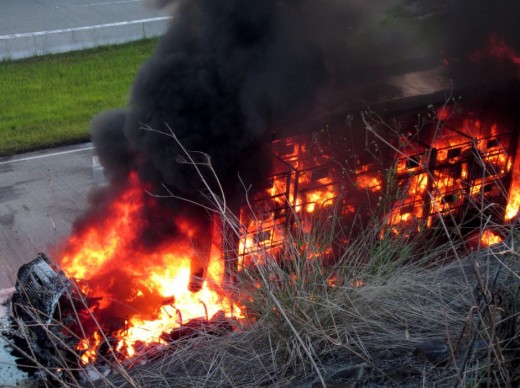 . .
Flames engulf a postal truck at Yelgun on the NSW north coast on December 18, 2011. The driver stopped the truck after noticing smoke pouring from the engine bay. He collected his belongings and departed the vehicle before the flames took hold.
.
[Source: ‘Truck burns at Yelgun”, by Kalindi Starick, ABC, 20111220, ^http://www.abc.net.au/news/2011-12-19/flames-engulf-a-postal-truck-at-yelgun-on-the-nsw-north-coast/3737752]
.
‘Teenage driver killed in truck collision’…two days ago
.
One woman was killed and five people were injured in two accidents involving B-double trucks.
- Engineers were called to the scene of a dramatic accident on the Gateway Motorway at Boondall in Brisbane about midday yesterday, when a B-double truckexploded after it and a car collided.
- On the Bruce Highway near Rockhampton, a 19-year-old woman died and four people were injured when a car and a B-double truck collided. Police said the station wagon tried to turn into the southbound lanes of theBruce Highway at Marmor just before 8pm on Friday when the car and truck, whichwas travelling in the northbound lane, collided. The 19-year-old driver was killed, while her three female passengers, two aged19 and one aged 18, were taken to Rockhampton hospital. The three are in a stable condition. The 65-year-old driver of the B-double was taken to hospital for precautionary treatment and has been released.
.
[Source: ‘Teenage driver killed in truck collision’, by Date: December 18 2011, Ellen Lutton, 20111218, Sydney Morning Herald, ^http://www.smh.com.au/queensland/teenage-driver-killed-in-truck-collision-20111217-1p0ax.html?skin=text-only]
.
‘Truck crash closes Melbourne freeway’
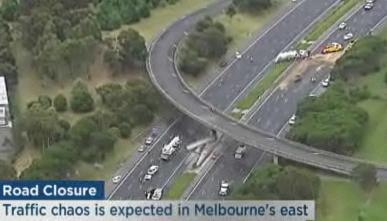 Melbourne’s Monash Freeway is closed in both directions after a semi-trailer crashed into a bridge pylon in the suburb of Mulgrave in the city’s south-east. Melbourne’s Monash Freeway is closed in both directions after a semi-trailer crashed into a bridge pylon in the suburb of Mulgrave in the city’s south-east.
.
[Source: ‘Truck crash closes Melbourne freeway’, ABC, 20111213, ^http://www.abc.net.au/news/2011-12-13/truck-crash-closes-melbourne-freeway/3727918]
.
‘Truckie quizzed over fatal crash’
Two people have died in a crash on the Pacific Highway near Yamba on the NewSouth Wales north coast.
A 62-year-old man and a 51-year-old woman from the Leeton area died when two cars collided about 11:00am (AEDT) today. A woman and three children who were in the other car have been taken to the Coffs Harbour Hospital. Police say a truck driver who was involved in the accident but failed to stop, was later pulled over at Ballina. Police are interviewing him. Rebecca Walsh, from the Traffic Management Centre, says the Pacific Highway is closed in both directions and vehicles are being diverted along the Summerland Way at Grafton.
.
[Source: ‘Truckie quizzed over fatal crash’, ABC, 20111111, ^http://www.abc.net.au/news/2011-11-11/truckie-quizzed-over-fatal-crash/3660874]
.
‘Chemical alert after truck rolls in Blue Mountains’
.
Fire crews are battling to contain a major chemical spill on the Great Western Highway at Katoomba in the Blue Mountains, after a truck overturned and 20,000 litres of a bright green industrial chemical poured out.
Protective bunds have been built around the spill site to stop the chemical, which is possibly a type of hydraulic fluid, reaching the iconic Leura cascades. The chemical is described as biodegradable, but it can be a toxic irritant to skins and eyes if touched.
Six fire crews were at the site at 5pm, plus a hazardous materials unit from St Marys, a spokesman for Fire and Rescue NSW said.National Parks rangers, Blue Mountains council staff and fire crews are monitoring the extent of the spilled fluid, some of which entered the drainage system. Council staff have poured gravel around the edge of the spill area to try and contain it. The truck rolled over at about 2pm, and the driver’s condition is unknown, although he or she was understood to not have been trapped in the vehicle.
.[Source: ‘Chemical alert after truck rolls in Blue Mountains’, by Ben Cubby, Environment Editor, 20111026, Sydney Morning Herald, ^http://www.theleader.com.au/news/national/national/environment/chemical-alert-after-truck-rolls-in-blue-mountains/2337200.aspx]
.
Editor: Subsequent reports by a Katoomba resident reported observing the green hydraulic fluid flow in quantities down Govetts Creek. The contaminant would probably have ended up in the World Heritage Area of the creek within the Grose Valley, but would the RTA, Blue Mountains Council or the National Parks Service care?
‘.
‘Truck overturns at Tabbimoble’ (Maclean)
.
A woman suffered minor injuries when the truck she was driving overturned on the Pacific Highway at Tabbimoble yesterday morning.
The B-double truck carrying general freight was heading north on the Pacific Highway and was about 2km south of the New Italy complex and 25km north of Maclean when it rolled shortly before 5am. The 46-year-old woman who was at the wheel of the Volvo semi-trailer complained of back pains and was taken by ambulance to Lismore Base Hospital. The highway was partially blocked for four hours while emergency service cleared away the debris. The accident occurred on what has become a notoriously black stretch of road where several fatalities have occurred in recent years.
.
[Source: ‘Truck overturns at Tabbimoble’, Northern Star, 20110609, ^ http://www.northernstar.com.au/story/2011/06/09/truck-overturns-tabbimoble/]
.
‘Cyclists mowed down by truck’
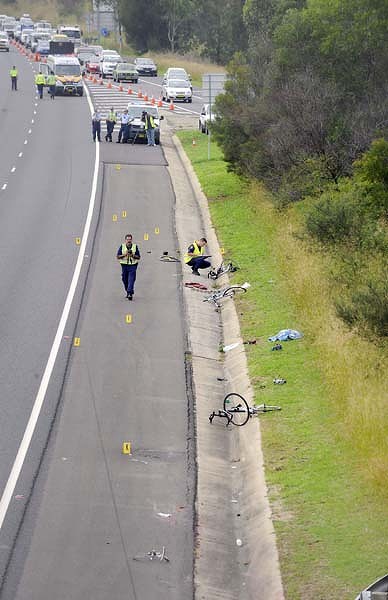 M4 Motorway (aka Trucking Expressway) on approach to the Blue Mountains
Photo: Adam Hollingworth M4 Motorway (aka Trucking Expressway) on approach to the Blue Mountains
Photo: Adam Hollingworth
.
One man has died after a truck veered into a group of cyclists on the M4 motorway.
Fatigue may have caused a truck driver to veer into the breakdown lane and mow down a group of cyclists, killing one, on the M4 in Sydney’s west. Police said a group of four cyclists were riding in the breakdown lane of the M4 near the Northern Road overpass at South Penrith when they were struck by a B-double truck about 7.40am today. A male cyclist died and the three others sustained serious injuries. The injured were taken to Nepean Hospital.
A WorkCover spokesman said a preliminary investigation was under way to ascertain whether driver fatigue caused the accident. Police said the male truck driver was taken to hospital for mandatory blood and urine tests. Police are investigating the cause of the crash.
.
[Source: ‘Cyclists mowed down by truck’, Sydney Morning Herald sourcing AAP , 20100410, ^ http://www.smh.com.au/nsw/cyclists-mowed-down-by-truck-20100410-rz7v.html]
.
‘Overtaking gamble cost highway driver his life, police believe’
.
One person has died after a truck carrying chemicals exploded after colliding with a car on the NSW north coast this morning.
Police believe a car driver’s early morning gamble in trying to pass a B-double truck on a no-overtaking stretch of the Pacific Highway cost him his life. The sedan was travelling southbound at Warrell Creek just before 4am when it appeared to pull out into the oncoming lane to overtake the truck. It then crashed head-on into a second, northbound, B-double carrying chemicals, Senior Constable Brian Carney of the Mid North Coast Crash Investigation Units aid.
.
[Source: ‘Overtaking gamble cost highway driver his life, police believe’, by Glenda Kwek, 20110405, ^http://www.smh.com.au/nsw/overtaking-gamble-cost-highway-driver-his-life-police-believe-20110405-1cz01.html]
.
‘Exploded fuel tanker closes Pacific Highway’
The Pacific Highway on the New South Wales north coast will be closed until New Year’s Day while crews clear a fuel tanker that exploded and killed the driver.
The tanker hauling 40,000 litres of fuel overturned and exploded on what is regarded by truckies as a notorious stretch of the highway, near Tintenbar, 10 km north of Ballina.
Authorities have set up a one-kilometre exclusion zone around the burning tankerand more than 100 firefighters equipped with breathing apparatus were sent to the scene.The ambulance service says the truck driver was killed in the blast, while two people have been freed from a nearby car after being trapped when powerlines came down on their vehicle. The second trailer of the B-double was thrown into a paddock where it leaked fuel into a nearby wetland, and police still cannot get to the cabin of the burnt truck where the driver’s body remains inside.
Another tanker driver, Gary, says the driver is one of their own but they do not know who.”It is sad to be holed up on the side of the road like this. And it’s sad for a driver that’s not going to go home to his family,” he said.
The truck was laden with diesel and unleaded fuel, which has now been mostly contained. Police say they will not be able to assess the damaged road until the scorched truck is moved, but they expect the Pacific Highway to be closed for the rest of today. Six other trucks are banked up behind the accident site unable to turn around.
.
[Source: ‘Exploded fuel tanker closes Pacific Highway’, ABC, 20101231, ^ http://www.abc.net.au/news/stories/2010/12/31/3104386.htm?site=goldcoast]
.
‘Truck lobby donations seem more important than people’s lives!‘
.
~ Dennis Plink, loc. cit.
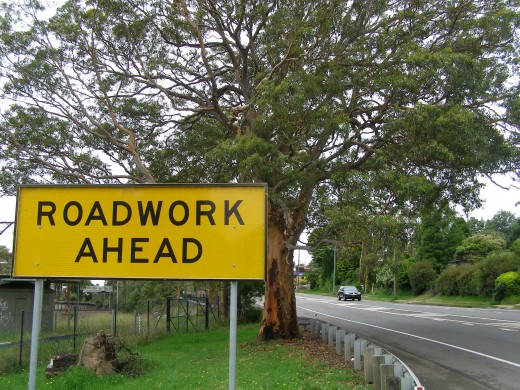 Native Angophora 300 years old.
The RTA’s Environment Manager says it’s in the way – Chip it!
– collateral damage for the Trucking Expressway
…note railway line on left Native Angophora 300 years old.
The RTA’s Environment Manager says it’s in the way – Chip it!
– collateral damage for the Trucking Expressway
…note railway line on left
>:/
.
Tags: ARA, Australasian Railway Association, b-doubles, B-triples, baby boomer, Blue Mountains, Blue Mountains Council, Blue Mountains National Park, Blue Mountains World Heritage Area, Bob Debus, cyclist, dangerous trucks, Eucalyptus oreades, fatal crash, Great Western Highway, Katoomba, Labor, Liberal, Liberal-Labor Party, National Parks Service, political donations, political penchant, residential amenity, Roads and Traffic Authority, RTA, significant trees, truck collision, truck crash, truck lobby donations, truck overturns, truck thinking, trucking expressway, trucking thinking, Yelgun
Posted in Blue Mountains (AU), Threats from Road Making | No Comments »
Add this post to Del.icio.us - Digg
Leave a Reply
You must be logged in to post a comment.
December 21st, 2011
The following article is sourced from ‘Missing peace in forest war’s coupe de grace‘ by Matthew Denholm, The Australian, 20111022,
^http://www.theaustralian.com.au/news/features/missing-peace-in-forest-wars-coupe-de-grace/story-e6frg6z6-122617.
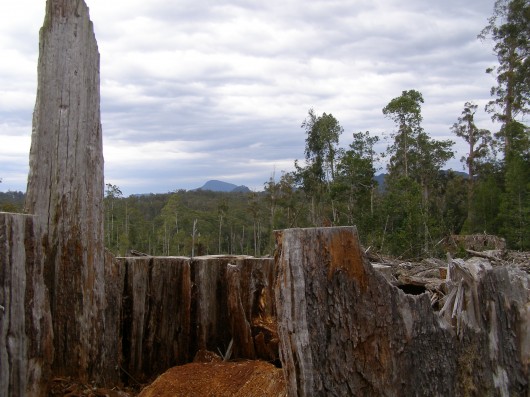 Forestry clearfell of old-growth in Tasmania’s Styx Valley
(Photo by Editor 20110928, free in public domain, click photo to enlarge) Forestry clearfell of old-growth in Tasmania’s Styx Valley
(Photo by Editor 20110928, free in public domain, click photo to enlarge)
.
More than two months (on 7th August 2011) after the landmark deal that promised to bring peace to Tasmania’s forests the protests – and the logging – continue unabated.
Funding for the struggling timber industry under the landmark $276 million Gillard-Giddings deal is starting to trickle out, but as yet not one tree has been saved!
Conservationists concede they may end up with nothing to show for 18 months of torturous negotiations, while many in the industry are sceptical that the promised peace will ever be achieved. The key decisions – on how many and which forests will be saved – are bogged down in difficult detail and alleged recalcitrance. Tasmania’s upper house, meanwhile, is lining up to sink the legislation needed to create the new national parks and reserves.
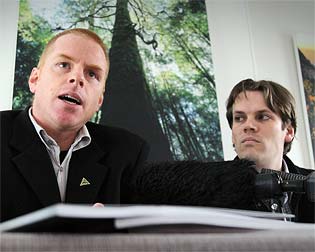 Environment Tasmania’s Phill Pullinger (right) with The Wilderness Society’s Vica Bayley Environment Tasmania’s Phill Pullinger (right) with The Wilderness Society’s Vica Bayley
.
A key conservationist and negotiator, Environment Tasmania director Phill Pullinger, concedes to Inquirer that events could conspire to see money flow to industry without one tree ever being saved.
“To be honest, it is a possibility,” says Pullinger, a Hobart doctor and former young Tasmanian of the year. “It has always been the case that the forest protection couldn’t be permanently delivered until the legislation goes through both houses of the Tasmanian parliament.”
.
That vote is a long way off, probably well into next year. The most immediate hurdle to overcome is a row over whether the state-owned Forestry Tasmania should be allowed to continue logging in 41 coupes (forest areas). All are within 430,000ha of forests set aside for “immediate” interim protection in the Gillard-Giddings deal of August 7, known as the Forests Intergovernmental Agreement or IGA.
Forestry Tasmania insists it needs to log in these coupes, a fraction of the total area, to maintain existing contracts to timber mills. Conservationists argue Forestry Tasmania could and should reschedule logging to less ecologically significant forests. The dispute was being sorted out by an independent rescheduling team appointed by state and federal governments. Inquirer has learned this process has gone badly for conservationists, with only seven of the 41 coupes able to be protected and five already logged. Forestry Tasmania and industry claim there simply is not time to do the rescheduling work – new roads, development of forest practices plans – necessary to shift to new areas quickly enough to meet existing timber contracts.
.
‘It is a fundamental problem that has weakened the (peace) process: you’ve got a government agency that is essentially working against the agreement. And the governments haven’t shown the stomach to pull the agency into line.’’
~ Phill Pullinger, Environment Tasmania, October 2011
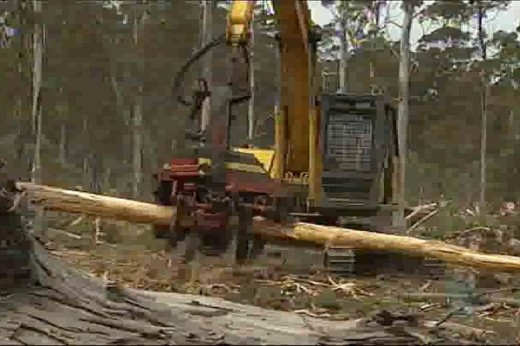
Conservationists claim this should have been done months ago, given that Forestry Tasmania was asked by the state government – its owner – to place a moratorium on logging in these forests in March.
“They (FT) have basically for 12 months now deliberately spun the wheels on that; there could easily have been a moratorium delivered six or nine months ago,” Pullinger says. “It is a fundamental problem that has weakened the (peace) process: you’ve got a government agency that is essentially working against the agreement. And the governments haven’t shown the stomach to pull the agency into line.”
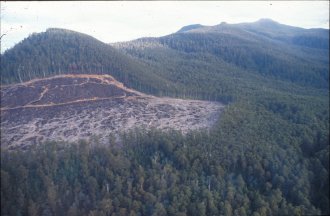
Crew-cutting pristine Tasmanian wilderness
.
This is rare intemperate talk from Pullinger, normally diplomatic and restrained as he tries to keep his constituency in the peace tent and the process on track.
It’s a sign things are not going well. Forestry Tasmania, a government business enterprise that reports to a board and is not necessary bound by ministerial direction, denies it has been dragging the chain. While it is the party with the most to lose – up to 572,000ha of native forest it manages for timber production – corporate relations manager Ken Jeffreys insists it is acting in good faith.
“Some people out there seem to think that FT has some maniacal glint in their eye and go out and harvest forests when it has no market because it has nothing better to do,” Jeffreys complains to Inquirer. “That is so far from common sense it’s hard to respond to.“
He insists Forestry Tasmania is happy to abide by the independent reschedulers’ verdict and points out that it has already rescheduled logging out of some contentious coupes. This fight over a handful of coupes has been holding up plans under the IGA for an overall immediate interim conservation agreement between the state, Forestry Tasmania and Canberra to protect the 430,000ha. Under the IGA, this interim agreement would protect those forests while an independent verification team determines the final size and location of the new permanent reserves.
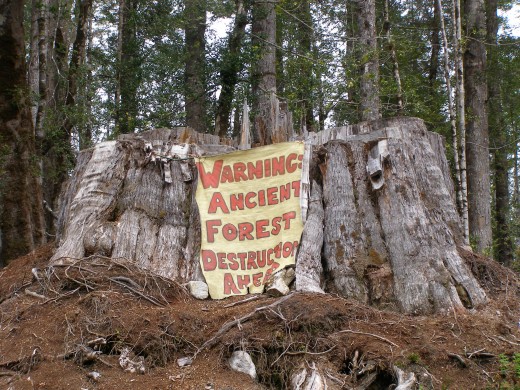 Ancient Myrtle Beech (Nothofagus cunninghamii)
chainsawed in the Upper Florentine Valley, Tasmania
(Photo by Editor 20110928, free in public domain, click photo to enlarge) Ancient Myrtle Beech (Nothofagus cunninghamii)
chainsawed in the Upper Florentine Valley, Tasmania
(Photo by Editor 20110928, free in public domain, click photo to enlarge)
.
IGA Independent Verification Team
.
The independent team, overseen by academic Jonathan West, will decide how much forest, of a larger 572,000ha nominated by green groups, is worthy of protection. West’s team will also test industry claims about how much timber it requires to meet existing contracts. Then it must decide how much forest can be protected while providing this resource. The job, which unrealistically is due to be completed by December 31, is the “forest wars” equivalent of deciding where exactly the boundaries of a Palestinian state should be drawn.
Conservation groups believe that most – if not all – of the 572,000ha can be protected, once a developing plantation resource is factored in.
.
Forestry Tasmania’s position
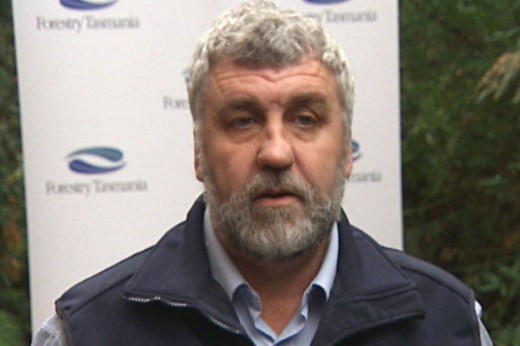
Forestry Tasmania chief, Bob Gordon
– what IGA? It’s logging business as usual to fill ‘orders’.
.
Forestry Tasmania stands by its modelling suggesting that no more than 300,000ha can be protected if it is to deliver on current timber contracts. Some in the industry believe only 250,000ha can be saved from the chainsaws. Neither of the industry figures is unlikely to be enough for conservationists, but may well be too much for Tasmania’s independent-dominated upper house. Several recent votes in the Legislative Council suggest it is opposed to the IGA and to more forest “lock-ups”. Its refusal to pass the reserves would leave conservationists relying on a federal-state conservation agreement to protect those forests.
While such an agreement would ban logging, it is legally uncertain if Forestry Tasmania could ignore this on the basis that it conflicts with its legislative or contractual obligations.
Jeffreys insists Forestry Tasmania would abide by any final agreement, subject to being able to meet those commitments – a big out if Forestry Tasmania decided to dig in for a battle.
.
Tony Burke’s position:
.
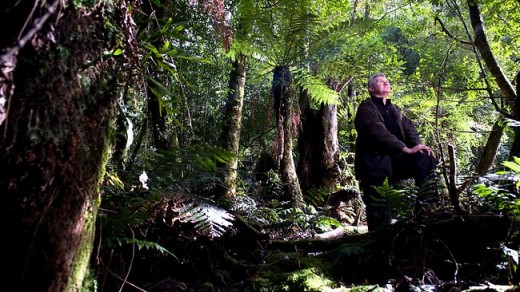 Federal Environment Minister Tony Burke
in Tasmania’s Wielangta forest, March 2011
(Photo by Matthew Newton, Source: The Australian ) Federal Environment Minister Tony Burke
in Tasmania’s Wielangta forest, March 2011
(Photo by Matthew Newton, Source: The Australian )
.
Despite the difficulties, federal Environment Minister Tony Burke remains confident he can pull off the kind of final “win-win” forest peace deal that has eluded so many of his predecessors. He tells Inquirer the alternative is a kind of mutually assured destruction, whereby the forests continue to fall as fast as the jobs.
The number of jobs in Tasmanian forestry has halved since 2008 from 6960 to 3460, due mainly to Japanese paper-makers boycotting woodchips sourced from native forests, Gunns exiting the industry in favour of a plantation-based pulp mill and as a result of the high Australian dollar.
“If you let the markets sort this one out without a co-ordinated strategy from state and federal government … then you end up with a terrible outcome for the Tassie economy … diabolical,” Burke says.
Initially as Forests minister and more recently as Environment Minister, Burke has been involved in the process from the beginning. The first in federal cabinet to twig to the potential to assist industry while securing a historic conservation outcome, he has repeatedly slipped quietly into Tasmania to do his own field work.
The former staffer to Graham Richardson has camped with greenies amid the giant eucalypts of the Styx Valley and toured sawmills and production forests. When the process has looked as if it were imploding, he has intervened with all sides to keep it on track. Inspired to join the ALP by landmark conservation battles such as the Daintree and Kakadu, Burke constantly stresses his desire to also secure a good outcome for jobs and industry.
He believes the (Tasmanian) Legislative Council will take a different view to new reserves when details are developed for a $120m federal regional development fund promised under the IGA. That money, to revitalise timber communities and diversify the Tasmanian economy, is contingent upon state parliament passing the new reserves legislation. No reserves; no $120m.
Burke, himself a former state upper house MP (in NSW), believes this cash for regions will ultimately win over the key 12 independent MLCs.
“Those MPs will have to look in the eyes of a whole lot of their constituents who are out of work and justify their actions,” he says. “I just don’t believe when it comes to it they’ll vote this down. This is the first time we have tried to deal with this issue with an independent process rather than a political fix. The irony this time is: can we stop politics from wrecking it, not from fixing it?”
He warns both sides will need to accept the outcome of the independent verification process. “They are honour-bound to accept the process – they created it,” he says.
This suggests Canberra will not be afraid to impose the verdict of the independent verification team if the two sides cannot embrace it – or at least an agreed variation of it. Such action may well see either side – timber or conservation – walk away.
Certainly, Pullinger won’t promise to accept the outcome if it is not embraced by both sides.
“If the independent verification group comes down and says … we are going to protect just a fraction of these forests … then – expert group or not – I don’t think anyone believes that is going to be able to deliver a lasting agreement.”
.
Editor:
The IGA deal is a deal is a promise. Why are Gillard and Giddings allowing Forestry Tasmania to renege on the deal by continuing to log these now protected native forests in Tasmania’s Styx Valley and southern forests. Why are Gillard and Giddings breaking their promise to Tasmanians?
IGA interim reserves are IGA interim reserves? The IGA offers millions in contractual compensation. So take the compensation Bob Gordon! You can’t have your compensation and interim reserves too!
Leave the bloody old growth alone!
 Prime Minister Julia Gillard, 2011
– do I really have to honour that forest deal?
(Photo: The Examiner) Prime Minister Julia Gillard, 2011
– do I really have to honour that forest deal?
(Photo: The Examiner)
.
Evidence of new logging despite Tasmanian Forests Agreement
.
[Source: ‘ Evidence of new logging despite Tasmanian Forests Intergovernmental Agreement requires urgent government action‘, by the Australian Conservation Foundation, 20110922, ^ http://www.thegreenpages.com.au/news/evidence-of-new-logging-despite-tasmanian-forests-intergovernmental-agreement-requires-urgent-government-action/]
.
Environment Tasmania, the Wilderness Society and the Australian Conservation Foundation have released a report assessing the status of logging in important native forests and photographs that show new logging activity in forest reserves prescribed by the Tasmanian Forests Intergovernmental Agreement (IGA).
“The settlement and retirement of Gunns’ native forest timber quotas has halved the demand for native forest timber from Forestry Tasmania, so there is no need or justification for logging within the forest reserve areas,” said Dr Phill Pullinger of Environment Tasmania.
“Wood supply for remaining sawmills can be provided from outside of the important native forests identified for protection,” Dr Pullinger said.
“Aerial photographs taken in late August and last week show Forestry Tasmania continues to log inside the 430,000 hectares of unique and important forests identified for immediate protection in the IGA,” said Vica Bayley of the Wilderness Society.
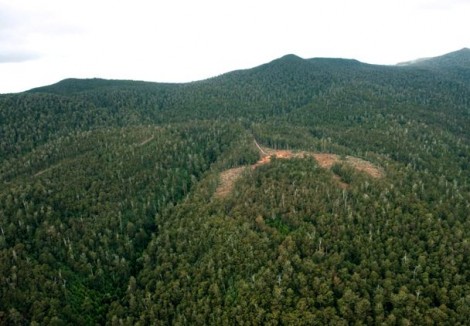
“In fact, our report and the new photos show Forestry Tasmania has not rescheduled logging outside this area and has even commenced logging new coupes since the IGA was signed.
“While we are encouraged to see progress on key components of the intergovernmental agreement — including the retirement of Gunns’ wood quota, funding for timber workers and contractors and the independent verification group — we have seen no progress on halting logging inside the nominated forest reserve areas,” Mr Bayley said.
“Environment groups again call on the state government to honour the agreement it has signed by directing Forestry Tasmania to declare the nominated forests as informal reserves and immediately appointing an independent expert to undertake the rescheduling,” said Denise Boyd of the Australian Conservation Foundation.
The report released today is part of environment group signatories’ ongoing commitment to implementing the IGA and will provide governments with verified, accurate information to help achieve the forest protection outcomes of the IGA. The state government must now ensure delivery of the critical plank of the IGA – forest protection.
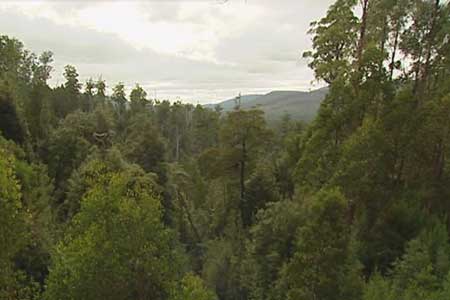
“We have seen no progress on halting logging inside the nominated forest reserve areas.”
~ Vica Bayley, The Wilderness Society
.
Forest protest continues in Mount Mueller Forest, Styx Valley (Tree Sit, Day 7)
.
Check out The ObserverTree protest website:
^http://observertree.org/

.
Tags: breaking promise, clearfell, Crew-cutting pristine Tasmanian wilderness, Environment Tasmania, Forestry Tasmania, IGA, interim reserves, Julia Gillard, Lara Giddings, Myrtle Beech, Nothofagus cunninghamii, Prime Minister Julia Gillard, Styx Forest, Styx Valley, Tasmania, Tasmanian Forests Intergovernmental Agreement, The ObserverTree, Tony Burke, Upper Florentine Valley
Posted in Tasmania (AU), Threats from Deforestation, Threats to Wild Tasmania | No Comments »
Add this post to Del.icio.us - Digg
Leave a Reply
You must be logged in to post a comment.
December 20th, 2011
 The Blue Gum Forest’s fire-scarred trees of December 2006
some of which have graced the Grose Valley in the Blue Mountains for hundreds of years.
Photo: Nick Moir (Source: Sydney Morning Herald, 20111211, Front Page) The Blue Gum Forest’s fire-scarred trees of December 2006
some of which have graced the Grose Valley in the Blue Mountains for hundreds of years.
Photo: Nick Moir (Source: Sydney Morning Herald, 20111211, Front Page)
.
The following articles are drawn from those by Gregg Borschmann, the first of which hit the front page of the Sydney Morning Herald on Monday 11th December 2006, following the massive bushfire conflagration that coalesced in the Grose Valley on 23rd November 2006.
From the community’s perspective, no noticeable lessons have been since learned by the Rural Fire Service (RFS) responsible. The prevailing bushfire management culture is that unless private property is directly, bushland is not valued and so not defended from bushfire. Indeed the approach is to let a bushfire burn as a defacto hazard reduction, so long as it doesn’t threaten human life or property. The RFS does not consider bushland an asset worth protecting from bushfire no matter what its conservation value, so with such a mindset such an ecological tragedy could well happen again.
.
‘The ghosts of an enchanted forest demand answers’
.
[Source: ^http://www.smh.com.au/news/national/the-ghosts-of-an-enchanted-forest-demand-answers/2006/12/10/1165685553891.html]
.
‘More than seventy years ago this forest inspired the birth of the modern Australian conservation movement. Today Blue Gum Forest stands forlorn in a bed of ash. But was it unnecessarily sacrificed because of aggressive control burning by firefighters focused on protecting people and property? That is the tough question being asked by scientists, fire experts and heritage managers as a result of the blaze in the Grose Valley of the upper Blue Mountains last month.
As the fate of the forest hangs in the balance, the State Government is facing demands for an independent review of the blaze amid claims it was made worse by control burning and inappropriate resources.
This comes against a backdrop of renewed warnings that Australia may be on the brink of a wave of species loss caused by climate change and more frequent and hotter fires. There are also claims that alternative “ecological” approaches to remote-area firefighting are underfunded and not taken seriously.
In an investigation of the Blue Mountains fires the Herald has spoken to experienced fire managers, fire experts and six senior sources in four agencies and uncovered numerous concerns and complaints.
- It was claimed that critical opportunities were lost in the first days to contain or extinguish the two original, separate fires.
- Evidence emerged that escaped backburns and spot fires meant the fires linked up and were made more dangerous to property and heritage assets – including the Blue Gum Forest. One manager said the townships of Hazelbrook, Woodford and Linden were a “bee’s dick” away from being burnt. Another described it as “our scariest moment”. Recognising the risk of the backburn strategy, one fire officer – before the lighting of a large backburn along the Bells Line of Road – publicly described that operation as “a big call”. It later escaped twice, advancing the fire down the Grose Valley.
- Concerns were voiced about the role of the NSW Rural Fire Service Commissioner, Phil Koperberg.
- Members of the upper Blue Mountains Rural Fire Service brigades were unhappy about the backburning strategy.
- There were doubts about the mix and sustainability of resources – several senior managers felt there were “too many trucks” and not enough skilled remote-area firefighters.
- Scientists, heritage managers and the public were angry that the region’s national and international heritage values were being compromised or ignored.
- There was anecdotal evidence that rare and even common species were being affected by the increased frequency and intensity of fires in the region.
- Annoyance was voiced over the environmental damage for hastily, poorly constructed fire trails and containment lines, and there were concerns about the bill for reconstruction of infrastructure, including walking tracks.

The fire manager and ecologist Nic Gellie, who was the fire management officer in the Blue Mountains for the NSW National Parks and Wildlife Service during the 1980s and ’90s, says the two original fires could have been put out with more rapid direct attack.
“Instead, backburning linked up the two fires and hugely enlarged the fire area … what we saw would be more accurately described as headfire burning, creating hot new fire fronts. While it protected the town of Blackheath, the plateau tops burnt intensely – and that created new problems both for management of the fire and the protection of biodiversity.
“When extreme fire weather, hot days and high winds arrived as predicted, the expanded fire zone was still not fully contained – and that was the cause of most of the high drama and danger that followed.”
In that dramatic week, Mr Gellie confronted Mr Koperberg with his concerns that the commissioner was interfering with the management of the fire by pushing hard for large backburns along the northern side of towns in the Blue Mountains from Mount Victoria to Faulconbridge, along what is known in firefighting circles as the “black line”.
The Herald has since confirmed from numerous senior sources that “overt and covert pressure” from head office was applied to the local incident management team responsible for fighting the fire.
There were also tensions relating to Mr Koperberg’s enthusiasm for continuation of the backburning strategy along the black line – even when milder weather, lower fuel levels and close-in containment were holding the fire.
Several sources say the most frightening threat to life and property came as the fire leapt onto the Lawson Ridge on “blow-up Wednesday” (November 22) – and that those spot fires almost certainly came from the collapse of the convection column associated with the intensification of the fire by the extensive backburns.
The Herald has also confirmed that
- The original fire lit by a lightning strike near Burra Korain Head inside the national park on Monday, November 13, could not be found on the first day. The following day, a remote area fire team had partly contained the fire – but was removed to fight the second fire. The original fire was left to burn unattended for the next couple of days;
- An escaped backburn was responsible for the most direct threat to houses during the two-week emergency, at Connaught Road in Blackheath. However, at a public meeting in Blackheath on Saturday night, the Rural Fire Service assistant commissioner Shane Fitzsimmons played down residents’ concerns about their lucky escape. “I don’t want to know about it. It’s incidental in the scheme of things.”
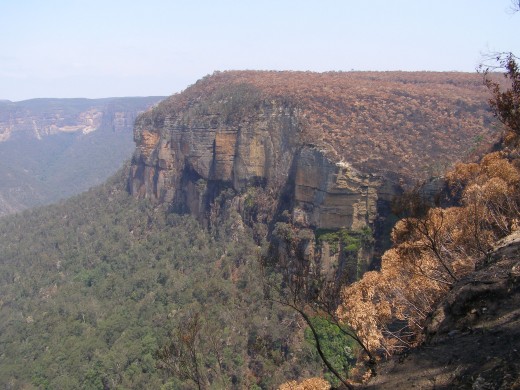 Blackheath escarpment broadscale backburn – “incidental in the scheme of things“?
(Photo by Editor 20061209, free in public domain, click photo to enlarge) Blackheath escarpment broadscale backburn – “incidental in the scheme of things“?
(Photo by Editor 20061209, free in public domain, click photo to enlarge)
.
Mr Koperberg, who is retiring to stand as a Labor candidate in next year’s state elections, rejected the criticisms of how the fire was fought.
He told the Herald: “The whole of the Grose Valley would have been burnt if we had not intervened in the way we did and property would have been threatened or lost. We are looking at a successful rather than an unsuccessful outcome.
“It’s controversial, but this is world’s best backburning practice – often it’s the only tool available to save some of the country.”
The commissioner rejected any criticism that he had exerted too much influence. “As commissioner, the buck stops with me. I don’t influence outcomes unless there is a strategy that is so ill-considered that I have to intervene.”
Mr Koperberg said it was “indisputable and irrefutable” that the Blue Mountains fire – similar to fires burning now in Victoria – was “unlike any that has been seen since European settlement”, because drought and the weather produced erratic and unpredictable fire behaviour.
.
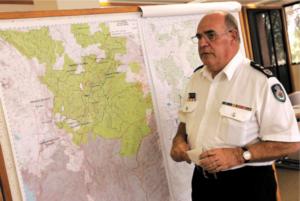 Phil Koperberg
NSW Rural Fire Service Commissioner at the time of the Grose Fire Phil Koperberg
NSW Rural Fire Service Commissioner at the time of the Grose Fire
.
The district manager of the Blue Mountains for the Rural Fire Service, Superintendent Mal Cronstedt, was the incident controller for the fire.
Asked if he would do anything differently, Mr Cronstedt answered: “Probably.” But other strategies might have also had unknown or unpredictable consequences, he said.
Jack Tolhurst, the deputy fire control officer (operations) for the Blue Mountains, said: “I am adamant that this fire was managed very well. We didn’t lose any lives or property and only half the Grose Valley was burnt.”
Mr Tolhurst, who has 50 years’ experience in the Blue Mountains, said: “This fire is the most contrary fire we have ever dealt with up here.”
John Merson, the executive director of the Blue Mountains World Heritage Institute, said fire management was being complicated by conditions possibly associated with climate change.
“With increased fire frequency and intensity, we are looking at a fundamental change in Australian ecosystems,” he said. “We will lose species. But we don’t know what will prosper and what will replace those disappearing species. It’s not a happy state. It’s a very tough call for firefighters trying to do what they think is the right thing when the game is no longer the same.
“What we are seeing is a reflex response that may no longer be appropriate and doesn’t take account of all the values we are trying to protect.”
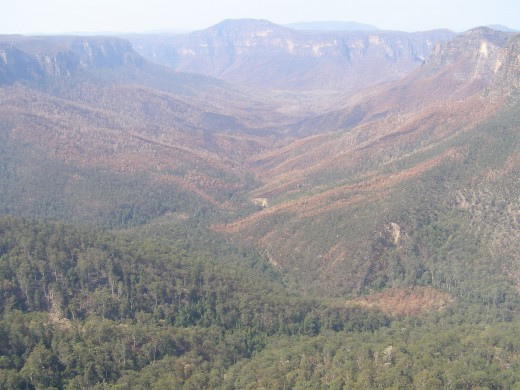 Grose Valley incinerated 23rd November 2006
(Photo by Editor 20061209, free in public domain, click photo to enlarge) Grose Valley incinerated 23rd November 2006
(Photo by Editor 20061209, free in public domain, click photo to enlarge)
..
‘The burning question’
.
[Source: ^http://www.smh.com.au/news/national/the-burning-question/2006/12/10/1165685553945.html]
.
‘A bushfire scars a precious forest – and sparks debate on how we fight fire in the era of climate change.
.
“Snow and sleet are falling on two bushfires burning in the Blue Mountains west of Sydney.” ~ ABC Radio, November 15 (2006).
The news report was almost flippant, something that could happen only in Dorothea Mackellar’s land of drought and flooding rains. Later that evening, two weeks from summer, Sydney had its coldest night in more than a century.
Over the past month – as an early summer collided with a late winter and a decade-long drought – NSW and Victoria have battled more than 100 bushfires. But of them all, last month’s Blue Mountains blaze reveals tensions and systemic problems that point to a looming crisis as bushfire fighters struggle to protect people, property, biodiversity and heritage values in a world beset by climate change.
The tensions have always been there – different cultures, different ways of imagining and managing the landscape. Perhaps they are illustrated by a joke told by two Rural Fire Service crew in the Blue Mountains. “How does the RFS put out a fire in your kitchen? By backburning your sitting room and library.” The joke barely disguises the clash between the imperative of saving lives and homes, and the desire to look after the land, and the biodiversity that underpins our social and economic lives.
For fire managers, whose first priority will always be saving people and property, the equation has become even more tortured with a series of class actions over fires in NSW and the ACT. As one observer put it: “These guys are in a position where they’re not going to take any chances. No one will ever sue over environmental damage.”

For bushfire management the debate tentatively started a couple of decades ago. The challenge was to do what poets, writers and painters have long grappled with – coming to terms with a country whose distinctiveness and recent evolutionary history have been forged in fire. Drought and climate change now promise to catapult that debate to centre stage.
It is perhaps no accident that such a defining fire has occurred in one of the great amphitheatres of the Australian story, the Grose Valley in the upper Blue Mountains. Charles Darwin passed by on horseback in 1836, and described the valley as “stupendous … magnificent”.
The Grose has long been a microcosm of how Australians see their country. In 1859 some of the first photos in Australia were taken in the valley. Proposals for rail lines and dams were forgotten or shelved. The first great forest conservation battle was fought and won there in 1931-32.
But now the valley is under threat from an old friend and foe – fire.
Ian Brown has worked on dozens of fires in the Blue Mountains. He is a former operations manager for the National Parks and Wildlife Service.
“All fires are complex and difficult, and this sure was a nasty fire … But we need lots of tools in the shed. Those hairy, big backburns on exposed ridges so close to a blow-up day with bad weather surprised me. Frightened me even.”
For Brown, even more worrying is the trend.
“Parts of the Grose have now burnt three times in 13 years and four times in 24 years. Most of those fires started from arson or accident. Many of the species and plant communities can’t survive that sort of hammering.”
Ross Bradstock, a fire ecologist, agrees. Professor Bradstock is the director of the new Centre for the Environmental Risk Management of Bushfires at the University of Wollongong, which is funded by the Department of Environment and Conservation and the Rural Fire Service. He says Australia stands out as one of the countries whose vegetation may be most affected by climate change.
Bradstock says that in south-eastern Australia the potential for shifts in fire frequency and intensity are “very high … If we’re going to have more drought we will have more big fires.”
But the story is complicated and compounded by the interaction between drought and fire. The plants most resistant to fire, most able to bounce back after burning, will be most affected by climate change. And the plants that are going to be advantaged by aridity will be knocked over by increased fire frequency. “In general, the flora is going to get whacked from both ends – it’s going to be hit by increased fire and climate change. It’s not looking good.”
.
Wyn Jones, an ecologist who worked for the wildlife service, says the extremely rare drumstick plant, Isopogon fletcheri, is a good example. There are thought to be no more than 200 specimens, restricted to the upper Grose. Last week, on a walk down into the Blue Gum Forest, Jones found three – all killed by the fire.
.
The NSW Rural Fire Service Commissioner, Phil Koperberg, has been a keen supporter of Bradstock’s centre. Asked if he agreed with the argument that the Grose had seen too much fire, Mr Koperberg replied: “It’s not a comment I disagree with, but had we not intervened in the way we did, the entire Grose Valley would have been burnt again, not half of it.”
The great irony of the fire is that it was better weather, low fuels and close-in containment firefighting that eventually stopped the fire – not big backburns.
Remote area firefighting techniques have been pioneered and perfected over recent decades by the wildlife service. In 2003 a federal select committee on bushfires supported the approach. It recommended fire authorities and public land managers implement principles of fire prevention and “rapid and effective initial attack”.
Nic Gellie, a fire ecologist and former fire manager, has helped the wildlife service pioneer ecological fire management. The models are there – but he says they have not been used often enough or properly.
Doubts have been expressed about the sustainability of the current remote area firefighting model. It is underfunded, and relies on a mix of paid parks service staff and fire service volunteers. Most agree the model is a good one, but not viable during a longer bushfire relying on volunteers.
The Sydney Catchment Authority pays $1 million for Catchment Remote Area Firefighting Teams in the Warragamba water supply area. It has always seemed like a lot of money. But it looks like a bargain stacked against the estimated cost of $10 million for the direct costs and rehabilitation of the Grose fire.
Curiously, one unexpected outcome of the great Grose fire may be that the valley sees more regular, planned fire – something the former wildlife service manager Ian Brown is considering.
“If climate change means that the Grose is going to get blasted every 12 years or less, then we need more than just the backburning strategy. We need to get better at initial attack and maybe also look at more planned burns before these crises. But actually getting those burns done – and done right – that’s the real challenge.”
It may be the only hope for Isopogon fletcheri.
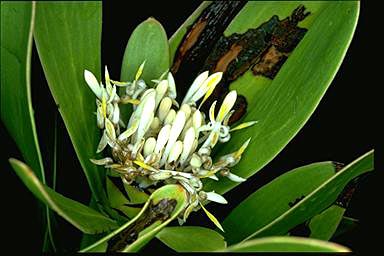 Fletcher’s Drumstricks (Isopogon fletcheri)
http://www.anbg.gov.au Fletcher’s Drumstricks (Isopogon fletcheri)
http://www.anbg.gov.au
.
. Distribution of Isopogon fletcheri is restricted to a very small area in the Blackheath district of the Blue Mountains.
Given restricted distribution, it is susceptible to local extinction due to environmental and demographic uncertainty and in particular pathogens such as Phytophthora cinnamomi. Distribution of Isopogon fletcheri is restricted to a very small area in the Blackheath district of the Blue Mountains.
Given restricted distribution, it is susceptible to local extinction due to environmental and demographic uncertainty and in particular pathogens such as Phytophthora cinnamomi.
What needs to be done to recover this species? Continued habitat protection.
http://www.threatenedspecies.environment.nsw.gov.au/tsprofile/profile.aspx?id=10440
.
.
What price now?
.
[Source: ^ http://www.smh.com.au/news/national/what-price-now/2006/12/10/1165685553948.html?page=2]
.
The Blue Gum Forest stands tall, straight and surreal in a fire-ground of still smouldering ash. Three weeks ago it was intensely burnt during bushfires in the Grose Valley. The future of the iconic forest – some trees are thought to be 200 to 300 years old – now hangs in the balance.
Last week the massive white-trunked blue gums were dropping their scorched leaves to reveal a stark and unrecognisable forest of tall trunks, bare limbs and fallen logs.
The director of the Colong Foundation for Wilderness, Keith Muir, did not speak out during the fires, but now he wants answers.
.
-
“Could the Blue Gum have been saved using other firefighting strategies that also protected life and property?
-
Was the fire that burnt this very special forest made more intense, unpredictable and extensive by massive backburning operations?
-
Was the Blue Gum sacrificed for the sake of a de facto fuel reduction exercise that didn’t consider heritage values?
-
We need answers. We need an independent inquiry. This is too important to happen again.”
.
In the early 1930s the Herald supported a campaign by bushwalkers to save the Blue Gum from grazing and agricultural development. It was the first successful Australian conservation campaign to protect an almost pure stand of tall mountain blue gum ( Eucalyptus deanei) on about 40 hectares of river flats in the rugged Grose Valley of the upper Blue Mountains. The bushwalkers raised £130 to buy the lease covering the forest and create the Blue Gum Forest Reserve.
The Herald visited the Blue Gum Forest again last week with a forest ecologist, Wyn Jones, and Ian Brown, former National Parks and Wildlife Service operations manager with overall responsibility for fire management. In 1994 Jones, then an ecologist with the service, helped to describe scientifically the rare and newly discovered Wollemi pine. He first saw the Blue Gum Forest more than 40 years ago. He has been involved with it professionally and as a bushwalker ever since.
He said the forest would re-shoot and regrow, but it remains to be seen when and how. He predicted its immediate future would be decided over the next six months. That would depend largely on the vagaries of climate. Severe wind storms, a hot dry summer or even persistent rain, fungal growth and insect attack could all compromise the forest’s ability to bounce back quickly.
More uncertain and potentially bleak is the long-term prognosis. Jones said changing fire regimes caused by humans could be further complicated by climate change, a recipe for more frequent and hotter fires.
The Blue Gum Forest has been burnt four or five times in less than 50 years: by wildfire in 1957, possibly 1968, and in 1982, 1994 and 2006.
“Without human interference , this forest may have been burnt once or perhaps twice in 50 years, not five times,” Jones said.
Jones is convinced cracks in majestic gums were caused by the fire. If they are deep enough to effectively ringbark the surviving trees, then the demise of the forest promises to be a slow and painful affair.
“The old Blue Gum Forest is gone,” he said. “We don’t know what the Blue Gum of the future will look like. We could be heading for strange and very different days.”
===========
‘Friends of the giants’
.
In 1931 the Herald’s conservation reporter, J.G. Lockley, writing under the name Redgum, led a campaign to save the Blue Gum Forest.
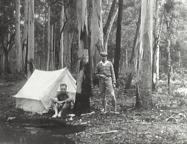
“To destroy the trees would be unforgivable vandalism .. if they are permitted to stay, they will stand straight and true for many generations … Every acre on which those grey gums are growing should be reserved for the distant days, when the nation will know the true worth of the giant trees, which are not understood.”
.
‘Blue Gum Lessons’
.
(Editor’s letter in the Blue Mountains Gazette, 20061220)
.
‘One of our most precious natural heritage assets, the Blue Gum Forest, has been allowed to be scorched by bushfire. This demands an independent enquiry into current fire fighting practices to ensure such a tragedy is not repeated.
Not a witch hunt, but what is needed is a constructive revision into improving bushfire fighting methods incorporating current research into the issue. The intensity and frequency of bushfires have become more prevalent due to disturbances by man, including climate change.
An enquiry should consider the assets worth saving; not just lives, homes and property but natural assets of the World Heritage Area. Fire fighting methods should seek to protect all these values. It seems back-burning, however well-intentioned, burnt out the Blue Gum. This is unacceptable. What went wrong? The future survival of our forests depends on how we manage fire.’
.
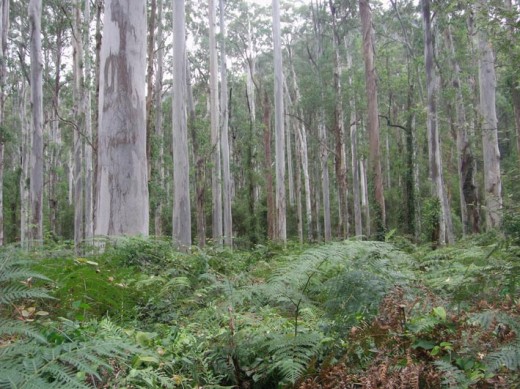
A Grose Valley Fire Forum was held at Mount Tomah on Saturday 17th February 2007, but the public were denied entry.
An independent enquiry was never conducted. A public enquiry was never conducted.
.
Tags: backburns, Blackheath, Blue Gum Forest, Blue Mountains, Blue Mountains World Heritage Area, broadscale backburning, ecological values, forest values, Grose Valley, Grose Valley Fires 2006, Isopogon fletcheri, Mal Cronstedt, old growth, Phil Koperberg, RFS, Rural Fire Service
Posted in Blue Mountains (AU), Threats from Bushfire | No Comments »
Add this post to Del.icio.us - Digg
Leave a Reply
You must be logged in to post a comment.
December 19th, 2011
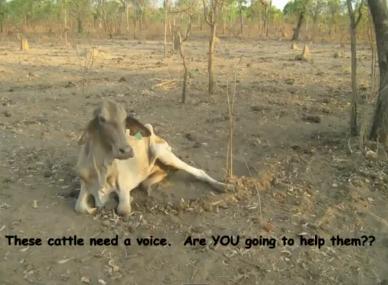 This is not Ethiopia…it is Mataranka Cattle Station in 2010 This is not Ethiopia…it is Mataranka Cattle Station in 2010
Northern Territory, Australia
[Source: ^http://www.youtube.com/watch?v=pMX7fAMSkXA]
.late
This Editor recalls travelling as an impressionable backpacker by chance through Mataranka some years ago in 1983, then again on a career mission in 1990. The first trip was a ‘gap year‘. The second trip was a personal mission driving from Melbourne via Adelaide, up the Stuart Highway, stopping at Victoria River Downs Station and ultimately arriving at Kununurra. My ambition was to acquire a commercial helicopter license, low-level endorsement and associated cattle mustering experience. It was secured through locally connected ‘Golden West Helicopters’ (Slingsby Helicopters) offering an ‘introductory‘ advantage to a parochial profession closed to outsiders. This was the aviation career lure, albeit achieved after $45,000 dispersed, licence acquired but leading into the 1991 recession then Prime Minister Paul Keating said ‘we had to have‘.
The benefits of hindsight they say, or life’s lesson.
It is an extremely hot place in inland northern Australia about 400 km south of Darwin characterised by grassy woodland savannah. Toward the end of the Dry Season, temperatures can exceed 50 degrees celsius in the sun. While the Brahman cattle breed has been long bred across northern Australia because of the breed’s adaptability to hotter climates, no animals can withstand such extreme heat. But worse, no animal can withstand starvation and abuse at the captive hand of cruel sadistic handlers.
At Mataranka Cattle Station, a 77,000 hectare commercial cattle station, between 2008 and 2010, hundreds of cattle as well as horses were cruelly treated, allowed to suffer and die from criminal neglect and starvation. Station Manager Ian Gray was in charge at the time. He was let off by the Northern Territory Government as part of a government cover up to protect the reputation of the cattle industry and of Charles Darwin University which controlled the cattle station. The instances of animal cruelty are perhaps the worst in Australia’s history. They came a time when many Australians become horrified by the footage of inhumane treatment of cattle in Indonesian abattoirs after being exported live from northern Australia.
The Australian beef cattle industry is promoted by the Northern Territory Government as one of Australia’s ‘premium export industries.’
At what cost?
.
“In northern Australia, beef cattle are raised on very large properties (stations) where they graze on native pastures and bush.”
~ CDU website
.
Not only is cattle farming in northern Australia treating northern Australian wilderness as one big cattle paddock and trampling the last remnants of savannah ecosystems, the cattle industry in northern Australia is savagely cruel, immoral and should be shut down. It is no surprise that the main buyer of cattle in northern Australia, Indonesia, is winding down the export trade. Indonesia has been very open about it becoming self-sufficient for years. Those involved in the live cattle export trade have worked themselves into a dead end industry. Based on the following account at Mataranka, the live cattle trade can’t end soon enough.
.
Update (20120103):
It has come to the editor’s attention through a reliable party that the station manager of Mataranka at the time, Ian Gray, has formally rebutted the NT Ombudsman’s report saying that he never maltreated cattle at Mataranka Station. It is anticipated that further insight into this matter will serve to provide a more balanced account of what happened. This article essentially reproduces already reported material from other sources, including the NT Ombudsman and the ABC, which are widely regarded as reliable sources, as well as video footage of the condition of the cattle.
The aim of the article is to raise general awareness of the particular animal cruelty reported at Mataranka Station over several years, plus more broadly of the unethical nature of the cattle industry in northern Australia. We are interested not just in raising awareness of animal cruelty and injustice against wildlife, but changing human behaviour and culture to eradicate cruel and harmful practices. We would like to pursue this subject with an aim of contributing to constructively change to the animal handling culture, harmful farming practices, policies, practices, laws and funding of government, industry and university so as to improve the triple bottom line standards of agriculture across northern Australia. We will be pleased to publish information that helps achieve these ends.
.
.
.
Mataranka Death Campl
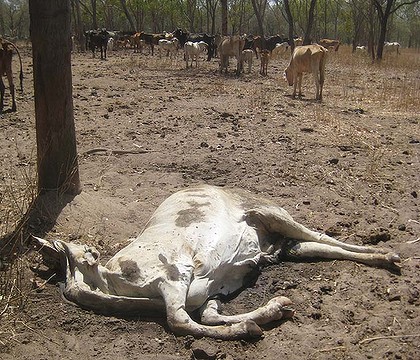
“At Mataranka Station from about August 2009 to December 2009 animals died from malnutrition, lack of water and others were destroyed. In many cases, livestock were tick infested, emaciated, thirsty, dehydrated, victims of attack from wild animals and meat ants. Some would have died an agonising death and those that survived were distressed, probably for months.”
.
[Source: Executive Summary, p.4, Volume 1, REPORT OF INVESTIGATION INTO THE TREATMENT OF CATTLE & HORSES AT CHARLES DARWIN UNIVERSITY MATARANKA STATION, by NT Ombudsman, 2010]
.
Northern Territory’s Charles Darwin University’s (CDU) teaching facility at Mataranka Station has been found to have condoned and ignored widespread animal cruelty, mistreatment, neglect, suffering and starvation of the Station’s 4500-strong herdover a three year period from 2008-2010.
Worse than that, Charles Darwin University in cahoots with the Labor Northern Territory Government have tried to excuse the treatment and sweep the matter under the carpet. The CDU website on 1st February 2010 tried to suggest excuses such as the photos being ‘taken toward the end of the Northern Territory dry season‘, that ‘only a small proportion were in extremely poor condition‘, that cows were ‘calving out of season‘ – the cows fault, and dismissing the abuse simply as ‘poor herd management‘.
It claims CDU acted as soon as it became aware of the problem in September 2009. Crap!
[Source: ^http://ext.cdu.edu.au/newsroom/a/2010/Pages/100201-Mataranka-Station-claims.aspx]
.
Charles Darwin University students exposed to the cruel animal treatment were disgusted, took photos, formally complained to the authorities (which did stuff all) and resigned from the university in disgust. University students training to work in the pastoral industry said they were distressed after seeing animals suffering and dying.
One witness observed carcasses being bulldozed into a mass grave and set alight after animals were starved and left to die on a university-run cattle station. Some of the animals were so weak they were eaten by meat ants or ripped apart by dingoes, wild dogs and feral pigs. Cattle were tick-infested, emaciated and dehydrated while others were too weak to stand and may have spent days on the ground before dying. Still-alive cattle were seen with their bowels ripped out by dingoes, unable to stand. The hoof of one horse fell off, which only occurs after a long period of neglect and months of suffering.
“Some [animals] would have died an agonising death and those that survived were distressed, probably for months,” Ms Richards said.
[Source: ‘Witness tells of mass animal grave‘, Lindsay Murdoch, Mataranka, Northern Territory, 20110425, ^http://www.smh.com.au/environment/animals/witness-tells-of-mass-animal-grave-20110424-1dt35.html]
====
Charles Darwin University’s Katherine Campus still offers a ‘Certificate III in Agriculture (Beef Production)‘ mainly out of Mataranka Station. The campus focuses on agricultural training for Vocational Education and Training (VET) courses, Australian Apprenticeships and traineeships in agriculture. Programs include the nationally-accredited Agriculture & Rural Production VET / TAFE Training Packages. Two-to-five day workshops in rural production skill areas including welding, vehicle maintenance, operating tractors, ride-ons and 4WD driving are also offered by the Katherine campus.
‘Do you want to work in an exciting, challenging industry that involves handling animals and machinery with extensive out-of-doors work? the beef cattle industry may be for you.‘… it promotes.
.
[Source: ^ http://www.comparecourses.com.au/Course/certificate-iii-in-agriculture-beef-production-50670.htm]
.
.
‘Sorry Saga’
.
This article has been prompted by the re-running of the ABC TV’s Landline programme, ‘Sorry saga‘ which was first broadcasted 20110727, and reported by Prue Adams
[Watch Landline Video: ^http://www.abc.net.au/landline/content/2010/s3276556.htm] – still available at the time of publishing.
We’ve seen and heard a fair bit lately about animal welfare. With most of the outrage aimed at the handling of Australian cattle exported live to Indonesia. But today, we’ll show a shocking case of cruelty that occurred right under the noses of government and university authorities in the Northern Territory.
It’s a sorry saga of mismanagement and neglect that’s dragged on for nearly two years. And despite a high-level report recommending prosecution, no one has ever been charged.
Prue Adams prepared this special report for Landline and we should warn some viewers may find images in this story distressing.
TOBY GORRINGE (VOICEOVER): In case you’re unaware, I wish to draw your attention to the serious nature of the animal welfare state of the cattle at Mataranka Station.
PRU ADAMS, PRESENTER: Every journey starts with one small step.
Toby Gorringe could never have foreseen the destination of the journey he began almost two years ago. It’s changed the course of his career and that of a handful of others. It’s led to several high-level inquiries, a well regarded university losing face, and a government scrambling to make departmental and legislative changes.
But still, this stockman and teacher, is far from satisfied.
TOBY GORRINGE, FMR LECTURER CHARLES DARWIN UNIVERSITY: I’ve been in the cattle industry all my life, that’s all I’ve ever done. If I wasn’t mustering cattle and whatever in the bush, I was working in the meat works or shoeing horses or something. So I’ve been around animals all my life. But you don’t have to see what happened there, that was just cruel. Just no other way to describe it. And they got away with it, I can’t believe it.
PRU ADAMS: When Charles Darwin University came into being eight years ago, it inherited the lease on Mataranka Station. An hour’s drive south of Katharine, Mataranka covers 770 square kilometres.
The property and its largely Brahman herd, have provided a useful tool for training students who want to work on the land.
VOICEOVER: So it provides a real life opportunity for pastoral industry training in the Northern Territory, which is vital for a very substantial part of the Northern Territory’s economy.
PRU ADAMS: But in mid 2009, a picture started emerging that all was not well at Mataranka.
A former NT Brahman breeders chairman, Ian Gray, was the station manager at the time and is seen here in an earlier Landline story. Toby Gorringe worked under Ian Gray. He says he complained to his boss that cattle were starving. Photos were taken of some of the dead and dying animals.
TOBY GORRINGE: I’ve seen cows lying down and can’t get up. And their calves are waiting around for them to get up and they can’t. So I’ve seen dead cows and dead calves together and dingos have eaten them alive, ants, pigs, things like that.
This is a letter I wrote to the HR of CDU.
PRU ADAMS: A vocational trainer in beef cattle and horse management, Toby Gorringe took his complaints further up the line within Charles Darwin University, including to the vice chancellor.
Still not satisfied, in October of 2009 he wrote to several Members of Parliament and in January last year contacted the Office of the Ombudsman.
TOBY GORRINGE: I kept going right up until I got to the Ombudsman, and at that time I didn’t trust anybody. And it’s still hard to trust someone, because everywhere I went I was shut down.
JULIE CARLSEN, NT DEPUTY OMBUDSMAN: The complaints were certainly valid and it has been documented quite widely that this is one of the worst animal cruelty cases in Australia.
PRU ADAMS: Julie Carlsen, is the Northern Territory’s Deputy Ombudsman. A former Western Australian police officer, she was put in charge of investigating what had, by the beginning of last year, become a series of complaints from staff, students and teachers at Mataranka Station.
JULIE CARLSEN: The nub of the investigation found that inadequate food was being provided to the animals, if it was provided at all. That watering points had broken down but were not being repaired in an appropriate time frame.
PRU ADAMS: And how many cattle did you find had died in that period?
JULIE CARLSEN: Our estimate was up to 800, and that estimate is based on the information provided to us by the students, by the staff members themselves, by contractors who attended, an independent investigator by the name of Tom Stockwell, who was employed by the University to conduct an investigation.

WOMAN ONE: These black marks around its neck are actually flies.
WOMAN TWO: Oh!
PRU ADAMS: A history of poor record keeping at the station and the death of hundreds of stock the previous year due to a badly managed bushfire, means the exact number of cattle that died will never really be known. The University disputes the Ombudsman’s figure of 800, saying it was more likely to be just over 200, which the Auditor General confirmed based on the University’s own evidence.
Nevertheless between 5 per cent and 18 per cent of the station’s cattle, and at least two horses, perished. And the Ombudsman’s report, tabled in Parliament last October, makes for grim reading.
EXTRACT FROM OMBUDSMAN’S REPORT: Depriving cattle and horses of food and water to the extent that they become so weak that they drop to the ground, is in my view, neglect as defined in the Animal Welfare Act. In one case neglect was so severe that hoof of a horse fell off. This only occurs when there has been months of suffering by the horse.
PRU ADAMS: The ombudsman blamed CDU, Charles Darwin University and…
EXTRACT FROM OMBUDSMAN’S REPORT: Specifically the station manager, for failing to provide the fundamental necessities required to sustain life.
PRU ADAMS: And the Office firmly believed someone should have been prosecuted for animal cruelty. No one ever has been.
JULIE CARLSEN: I personally can’t see why this matter was not given the importance it deserved. That the amount of animals that died, whether it was 200, or whether it was up to 800 was not significant enough for some action to be taken.
PRU ADAMS: Hello Mr Glover, how are you, pleased to meet you too.
The University’s vice chancellor is Professor Barney Glover. We met at a tour of Mataranka Station late last month.
PROF BARNEY GLOVER, VICE-CHANCELLOR CHARLES DARWIN UNIVERSITY: The University accepts the view of the Ombudsman in relation to that matter is that very poor management at the station, primarily related to the station manager at the time, was a major cause of the difficulties that we faced. But on top of that I think it’s also fair to say that the response to the crisis at the time, and I’m on the public record in acknowledging that by the University, was not quick enough to get supplementary feed to the cattle that were in distress and we should have been able to do more, more quickly.
PRU ADAMS: So what went wrong? To begin to answer that question you have to go back a few years when it was decided Mataranka Station would not just act as an education and training site but would also be operated as a commercial venture. Cattle would be bred for sale.
In May 2009 the beginning of the six-month dry season, one of those sales fell through. Meaning the station had more stock than it was able to carry during the hot, dry weather.
TOBY GORRINGE: Well, I seen cattle locked in small paddocks, which are holding paddocks, but they were locked in there for, well they turned out to be in there for over four months. And the weaners that were taken off their mothers were locked in the yards for four months and you could see the condition falling off them on a daily basis.
Cattle that are locked in yards for that period of time don’t get the supplements they need because you can’t feed it to them, they’re not being cattle, they’re just – they can’t act like cattle because they can’t go and walk and have a feed and have a drink when it suits them.
PRU ADAMS: The Katherine Research Station is about an hour’s drive north of Mataranka Station. It was from there, in early September 2009, that government livestock officers were dispatched to check out Toby Gorringe’s complaints. The inspectors later told the Ombudsman they were “absolutely horrified”. They reported the animals were “tick infested and starving”. There were “insufficient water” troughs. A departmental vet read the manager, Ian Gray, his rights, because “serious charges would be laid”.
Another officer later told the Ombudsman that “after 28 years of conducting inspections this was the worst case of neglect he had seen on such a large scale”.
The inspectors said they distributed some feed themselves, and even shot cattle that had fallen and couldn’t get up. But when it was reported back to their own Department of Resources and to the University, the situation was hosed down.
Landline’s attempts to speak with the inspectors on camera have been unsuccessful. A departmental email apparently warned staff not to be involved with our program. Instead, we were referred to Fran Kilgariff, who is new to the role of Animal Welfare Authority in the Department of Housing, Local Government and Regional Services.
FRAN KILGARIFF, ANIMAL WELFARE AUTHORITY: Well, I think what went wrong was that the animal welfare branch, historically, had been focused on small companion animals, dogs and cats and people’s pets, and were largely unprepared for something on that scale and with large animals.
PRU ADAMS: She agrees with the Ombudsman that there was confusion as to which authorities were responsible for livestock welfare.
FRAN KILGARIFF: Look, I think it’s fair to say that in many areas people were not focused on what… perhaps not focused is not the right word, there was not a clarity about what people’s roles were or what the responsibilities of various bodies were, and it’s only when you get an incident as tragic as this that people actually are jolted to think that they actually need to actually be really clear about what their roles and responsibilities are.
PRU ADAMS: In the Northern Territory, to teach with animals, the institution needs a licence. And also needs to establish an Animal Ethics Committee in line with the Animal Welfare Act. At Charles Darwin University, the same person who held the licence for Mataranka Station was also the chairperson of the ethics committee, as well as being Deputy Vice Chancellor of the University.
The Ombudsman called it “an irreconcilable conflict of interest”. That man is Professor Bob Wasson, who appeared before a parliamentary inquiry earlier this month.
(footage from the parliamentary inquiry)
PARLIAMENTARIAN: Were you part of the first inspection by the Animal Ethics Committee, of the station after the complaints were made?
PROFESSOR BOB WASSON: Yes, I was.
PARLIAMENTARIAN: And in that inspection, did you check the shed to see how much hay was in that shed?
BOB WASSON: Yes. There was zero.
PRU ADAMS: In his role on the ethics committee, Professor Wasson was notified very early on about the neglect at Mataranka Station.
Another AEC member reported “the professor would make excuses for the situation at Mataranka”.
(footage from the parliamentary inquiry)
BOB WASSON: I just want to make something very, very clear, and this is not an attempt at any way to shift responsibility. But the AEC was not the manager of Mataranka and I think some of this conversation has sort of blurred that boundary.
BARNEY GLOVER: When that conflict of interest was brought to his attention he immediately resigned to resolve the conflict of interest. Certainly my observations…
PRU ADAMS: From the committee but not from the university?
BARNEY GLOVER: No, but my observations of the Deputy Vice Chancellor’s role during the period of late 2009 and early 2010 was someone who was deeply concerned about the condition of the cattle at Mataranka and very committed to trying to address those difficulties.
PRU ADAMS: In October 2009 this man, Tom Stockwell, independent grazing consultant and owner of Sunday Creek Station was contacted by Professor Bob Wasson to investigate the situation at nearby Mataranka. His report backed up Toby Gorringe’s account of animal neglect and he recommended dismissal of station management.
VOICEOVER: A management system which starved animals to death and then left them for crows, dogs and ants to finish off is frankly distressing in the highest order.
PRU ADAMS: But Mr Stockwell’s recommendations were largely ignored.
Now it seems to me that it was quite apparent by late in 2009, October, November 2009, through Department of Resources reports and also the report by Tom Stockwell who was employed by the University to have a look at the situation…
BARNEY GLOVER: Contracted by the university.
PRU ADAMS: Contracted. It became very apparent that the management was somehow lacking here. Why wasn’t the manager, Ian Gray, sacked?
BARNEY GLOVER: We took into account, and the advice that was provided to me, the report from Tom Stockwell, which was a very comprehensive report. We also took into account the responses to that report by those who were named in the report adversely, in the context of natural justice. We took that into account, while the station manager was stood down. And the recommendation to me was to reinstate the station manager but with a series of conditions attached.
TOBY GORRINGE: So they put him back on; said he had no case to answer; he’s done nothing wrong. So Ian goes in there thinking he’s done nothing wrong. So CDU must be at fault there somewhere because they’ve already told him killing those cattle is not wrong. That’s how I look at it. They put him back on, you have no case to answer, that’s how it looks to me.
PRU ADAMS: Ian Gray was finally encouraged to leave Mataranka in June last year, almost a year after the first complaints were lodged and just as the Ombudsman’s findings were coming to light.
BARNEY GLOVER: The University negotiated a termination of employment contract of the station manager and he left the University.
I don’t believe it constitutes any sort of inducement.
PRU ADAMS: After a 30-year career, Mr Gray says he’s unable to get a cattle industry job and now works in mining. He’s bitter about being targeted by the University, the Ombudsman and the media and doesn’t want to appear on camera. His supervisor and the man who steadfastly supported Ian Gray, in the face of mounting criticism, was qualified university veterinarian, Dr Brian Hyme. He told the Ombudsman “Mataranka was being held to an impossible standard”. He’s also left the CDU to take up a job at a Queensland agricultural college. We spoke at length on the phone but he didn’t want to be quoted for fear of dragging his new employer into the saga.
In April this year, six months after the Ombudsman’s report was tabled in the Northern Territory Parliament, Minister, Malarndirri McCarthy, announced there would be no prosecutions. There’s just 12 months to bring a charge under the Animal Welfare Act and that time had expired.
MALARNDIRRI MCCARTHY, NT LOCAL GOVT MININSTER: It is deeply disappointing that no one will be prosecuted and yes, clearly it is too little too late.
PRU ADAMS: The Minister released two legal advice documents, one from January warning, one from January, warning “the limitation for starting prosecution would expire in April”. And the Opposition claimed it proved the Government was well aware time was running out.
JOHN ELFERINK, NT OPPOSITION JUSTICE SPOKESMAN: The fact that the Government sat on the January report when they still could have brought a prosecution, demonstrates that they were never interested in a prosecution in the first place and I wonder why that might be.
TOBY GORRINGE (reading from email): In case you’re unaware I wish to draw your attention…
PRU ADAMS: In fact Toby Gorringe and his partner sent emails to several members of Parliament, including the Chief Minister, as far back as October 2009. And a freedom of information request lodged by Landline reveals Minister McCarthy was being kept informed of the situation from the middle of last year. The Deputy Ombudsman met with the Minister in late June and showed her the photos of dead and dying animals.
JULIE CARLSEN: I don’t agree that a prosecution was not warranted. My personal view is that had action been taken when it was first brought to the attention of the University, by us, and also the fact that the Minister was advised that a prosecution probably would have been successful.
PRU ADAMS: There have been allegations the Northern Territory Government has stalled any action to make someone responsible for the events at Mataranka, in order to protect its own departmental handling, and the reputations of both the university and the cattle industry. Despite my numerous attempts, the Minister responsible would not make herself available to answer those allegations.
(speaking to Barney Glover)
PRU ADAMS: When the Northern Territory Government came out in April and said that there would be no likelihood of a prosecution, did you, as an organisation, Charles Darwin, as an organisation, feel you’d dodged a bullet?
BARNEY GLOVER: If a prosecution should have occurred they should have occurred and if they didn’t, that was a mistake on the part of the relevant agencies, not to have prosecuted. That’s not a matter of dodging a bullet. My view, based on the wealth of information that’s available now as a result of the very detailed Ombudsman’s report, and the very significant investigations the University’s undertaken, I would be surprised if a prosecution should not have proceeded in 2009.
PRU ADAMS: CDU maintains it issued instructions to ‘keep stock alive,’ and hundreds of cattle were sold to reduce the load. The Vice Chancellor is adamant the University did not interfere in any way with the Government’s decision to not prosecute.
BARNEY GLOVER: But as far as I’m aware never, at any time, was any suggestion made that anyone should take it easy on the University. Our obligation was to fix the problem and to ensure it could never occur again. We were responsible and we needed to take action. So we did not ask for, we did not seek, and we certainly never covered up any suggestion of the Government taking it easy on the University.
PRU ADAMS: OK, and then …
BARNEY GLOVER: Is that clear enough?
PRU ADAMS: That is clear enough. That is clear as a bell, and thank you.
BARNEY GLOVER: Nothing exists.
PRU ADAMS: With many of its students coming from interstate, the University is at pains to point out that things have changed for the better here at Mataranka Station. Hundreds of thousands of dollars has been spent on infrastructure. The animals are well fed and a new manager is under contract until 2013.
(footage driving around the station)
BRAD WALKER: We’ll just go for a quick drive out. We’ll head up the laneways here.
PRU ADAMS: With experience running other cattle stations, Brad Walker has been in charge of making sure there’s better use of paddocks, that there’s appropriate feed and supplement and that breeding the Brahman and composite cattle, gets back on the right track.
BRAD WALKER: There you go, there’s one cow just had a calf, sitting on the ground there now.
PRU ADAMS: A large, new dam provides an inviting spot for a herd of heifers.
The University’s grievance handling procedures have been overhauled and there’s a body which meets regularly to discuss the workings at Mataranka.
ELAINE GARDINER, MATARANKA STATION ADVISORY COMMITTEE: I’m an independent chairman of the Mataranka Station Advisory Committee and that comprises of one person from the University, two industry people, and a person from the Department of Resources in Katherine. So we have a fairly independent view of what’s going on.
PRU ADAMS: And are you absolutely convinced that if you found some element here that was not up to scratch, that the University would take immediate notice?
ELAINE GARDINER: Yes. The Vice Chancellor, I report to the Vice Chancellor after every meeting and he’s very aware of any issues that may arise having had to deal with the issues in the past.
MAN TALKING TO STUDENT AT STATION: And I need to see you riding in this yard…
PRU ADAMS: Charles Darwin University is also considering getting out of the cattle business. Maintaining the training at Mataranka but relinquishing the herd.
BARNEY GLOVER: From certainly the perspective of the University Council, our view is we should be focused on our core business and our core business is really training and education. And so for us to be operating a working cattle station is risky; this is not our business.
PRU ADAMS: The saga at the station has also kicked off a series of changes within government, including the appointment of more animal welfare officers.
FRAN KILGARIFF: We now are in no doubt that the department, that our department, Animal Welfare Branch, is the lead agency in any prosecution. That wasn’t really clear before.
(footage from the parliamentary inquiry)
PRU ADAMS: With the results of a council of Territory cooperation inquiry, due next month, the Animal Welfare Act is also under scrutiny.
FRAN KILGARIFF: Currently the statute of limitations within that act is 12 months, we’re looking at that to see whether that needs to be extended. I think nobody wants to sweep this under the carpet. It’s been such a tragic and disastrous sort of issue that nobody wants to sweep it under the carpet. What we need to do is learn from it.
PRU ADAMS: Toby Gorringe resigned from Charles Darwin University last month and has embarked on the next phase of his life at a community a few hundred kilometres away on the Roper River.
He will be teaching Indigenous teenagers how to ride horses.
TOBY GORRINGE: Horses can teach kids to be anything they want to be.
PRU ADAMS: He’s been scarred by his experience, and believes amidst the current live export debate the case at Mataranka focuses attention on animal welfare in our own country.
TOBY GORRINGE: Australia wants to go and complain about what’s happening in Indonesia and rightly so, so they should, but they want to have a look at their own backyard first. This is a training organisation, has done as bad or worse than what’s happened in Indonesia. So the Government wants to have a look at their own backyard before they go over to Indonesia and tell them what to do.
PRU ADAMS: So it’s been two years now, is it time to move on?
TOBY GORRINGE: Yeah, it’s time to move on. I’ve moved on. I’ve gone to Nucca (phonetic) to work for the school, but it’s very hard to move on mentally because no one’s been charged for what has happened at Mataranka Station. They seem to have got away with animal cruelty which I don’t believe in. And how they got away with it I’ll never know.’
.
.
NT Ombudsman Investigation – NT Government let everyone off scott free
.
The Northern Territory Ombudsman completed a report on the cruelty and neglect in 2010, which was tabled in the NT Parliament in October 2010.last year. The Ombudsman’s office is a place of last resort….
.
“Before making a complaint to us you are encouraged to take all possible steps to resolve your concerns directly with the relevant department. We will not normally investigate a complaint until you have exhausted all regular avenues of appeal or review available. We will assist you to make contact with the appropriate person within a department if needed.”
.
The Northern Territory Ombudsman says Charles Darwin University has not explained how 800 cattle starved to death on its teaching and commercial cattle station. The Ombudsman Carolyn Richards has released her report into the deaths that happened between September last year and May this year at Mataranka Station. The report has criticised the university and government departments for taking six months to properly respond to reports about the animal neglect.
‘Investigation into the Treatment of Cattle and Horses at Charles Darwin University Mataranka Station’
.
This report is about an investigation into the manner in which Charles Darwin University (CDU) managed livestock and conducted operations at the University’s Mataranka Station. The investigation was instigated on the Ombudsman’s Own Motion because of complaints made by people disturbed by the condition and treatment of cattle and horses at that property throughout 2009 and continuing into 2010.
.
- Investigation into the Treatment of Cattle, Horses at CDU Volume 1, 8MB [>Read Report]
- Volume 2 – Cover and Contents, 107KB [>Read Report]
- Volume 2 – pages 4-99, 12MB [>Read Report]
- Volume 2 – pages 100-169, 7MB [>Read Report]
- Volume 2 – pages 170-199, 3MB [>Read Report]
- Volume 2 – pages 200-end, 9MB [>Read Report]
.
Alternatively, download these report sections directly from the NT Ombudsman’s website:
[Source: NT Ombudsmans Office, ^ http://www.ombudsman.nt.gov.au/publications-reports/public-reports/]
.
.
‘Ombudsman slams cattle cruelty‘
[Source: ‘ Ombudsman slams cattle cruelty‘, by Lindsay Murdoch, Mataranka, 20110425, ^ http://www.theage.com.au/national/ombudsman-slams-cattle-cruelty-20110424-1dszj.html]

Carcasses were bulldozed into a mass grave and set alight after animals were starved and left to die on a university-run cattle station, according to a new witness in one of Australia’s worst cases of animal cruelty.
Northern Territory Ombudsman Carolyn Richards said the witness told her office about the incident involving about 800 cattle and horses on Mataranka Station in the Northern Territory, run by Charles Darwin University.
Some of the animals were so weak they were eaten by meat ants or ripped apart by dingoes, wild dogs and feral pigs.
But the university disputes the number of cattle and horses that died, putting it at about 216.
Ms Richards told The Age the grave was on an isolated part of the station, explaining why her estimate differs from the university’s.
The witness, whose name has not been made public, came forward after the Ombudsman had completed a report on the cruelty and neglect which was tabled in the NT Parliament in October last year, Ms Richards said.
Barney Glover, the university’s vice-chancellor, said he had not been told about the new evidence and would contact the Ombudsman about it.
He said the university based its estimate on a study it commissioned last year and physical evidence on the property.
Ms Richards said she was devastated that the NT government had failed to prosecute anyone over offences that occurred on the 77,000-hectare station, 400 kilometres south of Darwin, in 2009 and last year.
In her report, Ms Richards said many cattle on the station were tick infested, emaciated and dehydrated while others were too weak to stand and may have spent days on the ground before dying.
Still-alive cattle were seen with their bowels ripped out by dingoes, unable to stand.
University students training to work in the pastoral industry said they were distressed after seeing animals suffering and dying.
The experience caused some to end their ambition to work in the industry.
Professor Glover denied that the university had played down the cruelty.
“It wouldn’t matter if there was one cow or 200 cows … it is unacceptable that a university would be put in a situation where animals under our care suffered unnecessarily,” he said.
Professor Glover said the university was looking to divest itself of management of the property and cattle while using the station as a base to train students.
The station has a new manager, the number of cattle has been reduced from 4124 in 2009 and the university has set up a Mataranka Advisory Committee.
Melina Tensen, RSPCA Australia’s scientific officer for farm animals, said regardless of how many animals perished “it was the state of the suffering that was horrific … This is up there among the worst cruelty cases Australia has seen,” she said.
.
.
‘Mataranka Station cattle death questions remain‘
.
[Source: ‘ Mataranka Station cattle death questions remain‘, by Emma Masters, 20111027, ^ http://www.abc.net.au/news/2011-10-27/20111027-mataranka-cattle-report-reaction/3604474]
.
An investigation into the starvation of cattle at a Northern Territory property has been unable to determine how many animals died two years ago.
The final report of a parliamentary inquiry into animal welfare was tabled in Parliament yesterday.
The inquiry says it received conflicting estimates on the number of deaths at the Charles Darwin University training property at Mataranka station, which ranged from 200 to more than 1,000.
It concedes the number will never be known because of poorly kept records.
The Council of Territory Cooperation report has recommended a single agency be responsible for the Local Government Act and that animal welfare laws be strengthened.
Local Government Minister Malarndirri McCarthy says she and her department failed in their investigation of the case.
The report also found that Ms McCarthy failed to direct an investigation, let alone a prosecution, reflecting poor judgement.
She says she will be taking that on board and reporting back to Parliament during November sittings.
“What I have said from the outset is this was an absolute disgrace,” she said.
Ms McCarthy says she and her agency were not blameless in the case.
.
.
‘Department boss regrets cattle deaths’
.
[Source: ‘Department boss regrets cattle deaths‘, ABC, by Eric Tlozek, 20110630, ^http://www.abc.net.au/news/2011-06-30/department-boss-regrets-cattle-deaths/2777674]
.
The head of a Northern Territory Government department responsible for animal welfare inspections has told a parliamentary committee he wished his officers had investigated cattle deaths at Mataranka Station earlier.
In 2009, hundreds of cattle died from neglect at the station, 400 kilometres south-east of Darwin.
The Territory ombudsman asked the Department of Housing, Local Government and Regional Services to investigate the matter in June last year. However, the department failed to act within the statutory time limit for animal welfare prosecutions, even though the ombudsman had provided officers with a detailed file of evidence against the station manager.
Department chief executive Ken Davies told the Council of Territory Cooperation today that he regrets that failure to act.
“With the benefit of hindsight, I wish we had, in a nutshell,” he said.
“There is no doubt, given what we now know and our investigative capacity in our Animal Welfare Branch, that a situation like has occurred there, would not happen again.”
Earlier, the vice-chancellor of Charles Darwin University (CDU), which operates Mataranka Station as a training facility, told the committee he does not know why efforts to stop the cattle starving to death were too slow.
Barney Glover says university management first received complaints about the condition of cattle on Mataranka Station in August 2009.
The Territory ombudsman, who investigated the cattle deaths, found that provable incidents of animal cruelty were still occurring in September 2009.
The ombudsman gave the government a detailed file last June containing evidence about animal cruelty.
The Animal Welfare Authority failed to act on her advice to prosecute.
A statutory deadline for prosecutions of those responsible expired in October.
The Ombudsman also said poor management by CDU was partially responsible for the deaths, and that systemic failings in three government departments allowed people to avoid penalty.
Mr Glover says he regrets the university’s attempts to save the cattle were not fast enough for many of them.
“I am on the record as being very concerned that our actions were not quick enough, that our actions were tardy,” he said.
“Whether that is because of inaction of individuals, or whether it is simply because getting feed and water to those animals was just not possible to be done quickly enough, I don’t know.”
A report into the Animal Welfare Act in 2007 recommended extending the statutory time limit for prosecutions and expanding the scope of animal cruelty offences.
Yesterday, Mr Davies told the committee he believes the Act could be improved.
.
.
Recommended actions to restore NT moral leadership:
.
It is clear that the following needs to happen to have a chance of restoring community trust in Northern Territory Government ‘moral leadership’:
.
- Mataranka Station Manager Ian Gray, along with colleagues Tim Biggs and Spud Thomas to be prosecuted with mass animal cruelty to the full extent of the law
- Acting Station Manager of Mataranka Station from September 2008, Douglas Jenkins, to be prosecuted with mass animal cruelty to the full extent of the law
- Charles Darwin University’s Katherine Campus Director of Science & Primary Industries, Dr Brian Heim, to be sacked
- Mr Don Zoellner (Pro Vice-Chancellor VET) to be sacked
- Chair of Charles Darwin University’s Animal Ethics Committee , Professor Robert Wasson, to be sacked
- Charles Darwin University’s vice-chancellor, Barney Glover, to be sacked
- NT Local Government Minister Malarndirri McCarthy to be sacked
- Former NT Local Government Minister Rob Knight to be sacked
- Department of Housing, Local Government and Regional Services, Ken Davies, to be sacked
- Mataranka Station to close down
- Charles Darwin University to be prohibited from running agricultural training for not less than 20 years, then to show cause why it may resume
- The Northern Territory Livestock Act to be repealed and superseded with much stricter national legislation, modelled along the provisions of the Animal Welfare Act.
.
Regrettably, yet more likely, is that the Northern Territory (NT) Government’s anachronistic business-as-usual culture has a reputation such that the NT community sees influential vested interest rural heavyweights in bed with NT government department management and so steering each successive Liberal and Labor government policy.
Is it any wonder that all sense of NT community trust in the political process is typically ridiculed as a corrupt.
The Mataranka Death Camp is yet another graphic instance of NT Gov’mnt anachronistic corruption – ‘out of sight out of mind‘.
.
Legacy Video: ^http://www.youtube.com/watch?v=pMX7fAMSkXA
(Click to play video, adjust volume as it includes audio)
Tags: animal cruelty, animal ethics, Australia's live export trade, Certificate III in Agriculture, Charles Darwin University, dehydrated, emaciated, Katherine Campus, malnutrition, Mataranka Death Camp, Mataranka Station, moral leadership, Northern Territory Government, NT moral leadership, NT Ombudsman, pastoral industry, starving cattle, Threats from Farming, tick-infested, Top End Cattle
Posted in Threats from Farming | Comments Off on Mataranka cruelty – NT Government complicit
Add this post to Del.icio.us - Digg
December 15th, 2011
“The moment one definitely commits oneself, then providence moves too. All sorts of things occur to help one that would never otherwise occurred. A whole stream of events issues from the decision, raising in one’s favor all manner of unforeseen incidents and meetings and material assistance which no man could have dreamed would have come his way. Whatever you can do or dream you can, begin it. Boldness has genius, power and magic in it. Begin it now.”
~ attributed to Goethe.
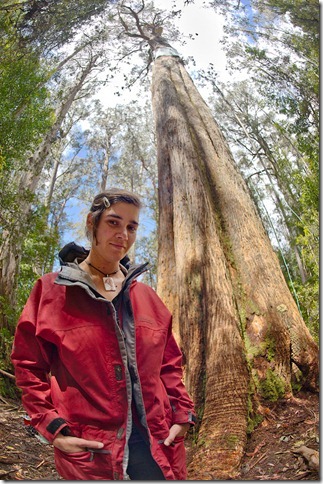 Miranda – Defender of Tasmania’s Forest Heritage
at the foot of ‘The Observer Tree‘
Mount Mueller Forest, Styx Valley, Tasmania
Miranda – Defender of Tasmania’s Forest Heritage
at the foot of ‘The Observer Tree‘
Mount Mueller Forest, Styx Valley, Tasmania
.
One young Tasmanian woman, charged with a deep commitment to her natural island heritage, continues to be prepared to do more to protect Tasmanian old growth forests than most Tasmanians. Miranda Gibson of Still Wild Still Threatened is certainly prepared to do more than the current (read ‘temporary‘) Premier of Tasmania Lara Giddings, and more than the current (read ‘temporary‘) Prime Minister of Australia, Julia Gillard, who have quickly turned their backs on Tasmanians to more populist party-political issues of the day.
.
 Tasmania’s Forest Wars
– what the Intergovernmental Agreement is supposed to resolve. Tasmania’s Forest Wars
– what the Intergovernmental Agreement is supposed to resolve.
.
Gillard and Giddings in breach of Tasmania’s 2011 Forest Agreement
.
Tasmanians are condemning government delinquency on meeting the conservation goals contained in the Gillard Labor Government’s Forests Intergovernmental Agreement (IGA) signed and promised to all Tasmanians in Launceston on 7th August 2011.
 Giddings and Gillard
– hollow Labor promises Giddings and Gillard
– hollow Labor promises
.
IGA Clause 25 states:
.
‘The State will immediately place the 430,000 ha of native forest identified in Attachment A (other than any areas which are not State forest) from the 572,000 ha nominated by ENGOs through the Statement of Principles process, into Informal Reserves.’
.
IGA Clause 27 states:
.
‘In the event that Forestry Tasmania reports that it cannot meet contractual requirements from production resources outside the nominated 430,000 ha the Governments will undertake the following steps. First, an independent expert will be jointly appointed by the Governments to review scheduling and other relevant data and attempt to reschedule harvesting activities so as to meet the requirements of contracts and maintain the interim protection of 430,000 ha. In the event that the independent expert concludes it is impossible to achieve this, the Commonwealth will compensate the contract holder for the value of lost profits and unavoidable costs.’
.
Gillard’s fly-in to Launceston on 7th August 2011 to sign and celebrate the Tasmanian Forests Intergovernmental Agreement with Labor mate Giddings was not a mere plaque unveiling, it was a Tasmanian landmark agreement to provide certainty for Tasmania’s forestry industry, support local jobs and communities, and protect the state’s ancient forests. It deserves the respect of commitment and follow through on promise.
On the one hand it has funded Forestry and its associated families hundreds of millions and with a dignified exit from logging and transition to alternate trades. On the other hand Gillard’s Forest Agreement guarantees protection for Tasmania’s natural but threatened heritage – its most iconic ancient forests, immediately placing 430,000 hectares of iconic old growth native forest into informal reserve – the Styx, Upper Florentine, Huon, Picton and Weld Valleys and the Great Western Tiers, Tarkine and Wielangta.
.
Gillard’s promise made to the Australian people (Prime Minister Gillard’s official website):
.
‘These forests will not be accessed for harvest while verification takes place.‘.
Well, verification is still taking place. And Bill Kelty, who brokered the deal, seems to have run to the hills.
Such a landmark State-wide agreement that promises a ‘strong foundation‘ is hollow if the leadership waddles off to be distracted by other issue so the day, without the committed delegation of trusted lieutenants to see through on implementation. Predecessor PM Kevin Rudd failed classically on the implementation phase of his policy – insulation being his and Garrett’s multi-million dollar incompetent legacy.
“The Australian and Tasmanian governments are taking too long to implement the intergovernmental agreement. If they can get their act together to offer contractors exit packages then they can honour the conservation agreement as well.” Greens Senator Bob Brown has said. “Four months later not one hectare has been protected and Forestry Tasmania continues to fell these magnificent trees as fast as they can put the roads in. All up, more than 10km2 of our wild forests will be destroyed“, Greens Senator Brown said.
All political leaders, while dancing on mountains of power and influence, pragmatically realise that their time in office is temporary. Status quo is not a characteristic of modern democratic politics. What matters most in political careers is legacy. Australia’s current Prime Minister Julia Gillard is starting to stare that legacy in the face as she allows Premier Lara Giddings to breaking the $276 million promise by backing Forestry Tasmania’s current logging of the 430,000 hectares of old growth forest protected under the Gillard Government’s Agreement.
.
Tasmanian Betrayal
.
Gillard and Giddings have allowed Forestry Tasmania to log the protected 430,000 hectares, ignoring the prescribed compensation requirement. Gillard and Giddings have blatantly reneged on their core promise in the Agreement to cease logging and to protect these forests. Gillard and Giddings have betrayed the Tasmanian and Australian people. They have no mandate to stay in power. Their broken promises are to be their legacies.
.
“Those who cannot work with their hearts achieve but a hollow, half-hearted success that breeds bitterness all around”
~ Abdul Kalam, President of India (b.1931)
 Styx Valley Giants being massacred by State logger ‘Forestry Tasmania’ Styx Valley Giants being massacred by State logger ‘Forestry Tasmania’
.
Tasmania sells itself as ‘the natural state’. But there is a gap between rhetoric and reality as logging of old-growth forests continues – to international dismay.
“And they have these big logs, and you just know they are coming from old-growth forests…I don’t think I could take living there and seeing them every day knowing (the trees) are going mostly to woodchips.” ~ Larraine Herrick or Tumbarumba, Snowy Mountains, New South Wales.
But the Styx has been, and (is continuing) to be, logged by the timber industry in a state in which questions have been repeatedly raised about whether cronyism, corruption and deception underlie the management of forests. Only discovered in 2002, El Grande was a Eucalyptus regnans with a 19-metre circumference. Last autumn (2003), it was killed when a regeneration burn went wrong. Its demise helped fuel a midwinter protest that drew more than 2000 people to the Styx Valley. There, The Wilderness Society and Greenpeace began a tree-sit, 65 metres up a threatened giant eucalypt called Gandalf Staff.
.
[Source: ‘Tasmania: seeing the wood but not the trees‘, by Melissa Fyfe and Andrew Darby, The Age Newspaper, 20040313, ^http://www.theage.com.au/news/science/tasmania-seeing-the-wood-but-not-the-trees/2004/03/13/1078594604573.html]
.
 ‘El Grande’
Australia’s largest tree burned to death in 2003 by Forestry Tasmania’s incompetence ‘El Grande’
Australia’s largest tree burned to death in 2003 by Forestry Tasmania’s incompetence
.
Tasmanian forests activist organisation Still Wild Still Threatened have called on the Federal and State governments to honour a $276 million forest deal made on 7th August 2011.
“This deal has already seen $35 million delivered to Forestry Tasmania and Gunns Ltd. without protecting a single tree” said Still Wild Still Threatened spokesperson Ali Alishah.
“It is clear that by backing Forestry Tasmania’s destructive practices within the identified 430,000 ha area of high conservation value native forest, the State and Federal Governments are in direct violation of Clauses 25 and 27 of their own Inter Governmental Agreement.” said Mr. Alishah.
.
.
.
The Observer Tree

Miranda Gibson on top of The Observer Tree
Totally committed to Tasmanian Forests,
unlike Gillard and Giddings hollow words.
.
Still Wild Still Threatened have this week launched a new tool in the fight to protect Tasmania’s forests today, unveiling the ‘ObserverTree‘, a 17-storey high tree sit and media centre equipped with the technology to record footage of logging operations and stream these images live to the world via the internet.
The Observer Tree is located in the Styx Forest below Mt Mueller, in Tasmania’s western wilderness, part of the 430,000 ha of forest that was supposed to receive immediate protection under the federal-state agreement on forests (the IGA). The Observer Tree is situated at the head of a section of Styx Forest currently targeted for logging by Forestry Tasmania.
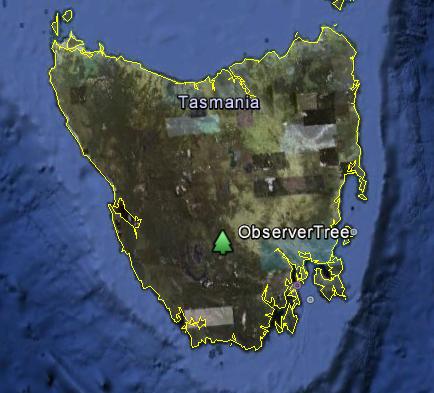 ‘Observer Tree’ location
^http://observertree.org/2011/12/15/observertree-on-google-maps/
‘Observer Tree’ location
^http://observertree.org/2011/12/15/observertree-on-google-maps/
.
Teacher, author and forest activist, Miranda Gibson, has vowed to occupy the tree-platform continuously, until real protection is secured for Tasmania’s forests. Ms Gibson will maintain a daily blog and upload video updates during her stay in the tree, documenting the struggle to protect Tasmania’s forests to concerned people all over the globe.
‘We have used the internet to connect this spectacular patch of threatened Tasmanian forest to the world. The Observer Tree will transmit images and information about the value of the thousands of hectares of forest that remain threatened if Julia Gillard does not keep her word. People across Australia and the globe will have the opportunity to view bear witness to the wasteful destruction of these forests and hear from the people fighting to protect them,’ said Ms Gibson.
For the first time their actual logging will be broadcast live internationally via the web.
Website: ^http://www.observertree.org
Facebook: ^http://www.facebook.com/#!/pages/ObserverTree/152795598158969
Download Google Earth (93MB): GoTo: ^http://www.google.com/earth/download/ge/
.
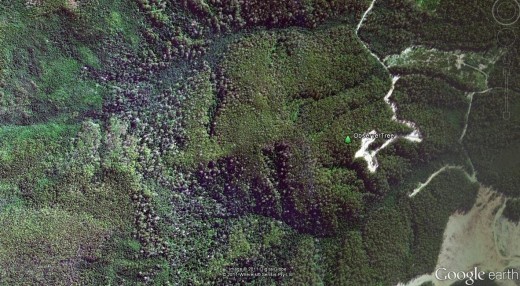 Google Earth’s satellite image of the Observer Tree in dense old-growth, adjacent to Forestry Tasmania’s fresh logging road
(click photo to enlarge) Google Earth’s satellite image of the Observer Tree in dense old-growth, adjacent to Forestry Tasmania’s fresh logging road
(click photo to enlarge)
.
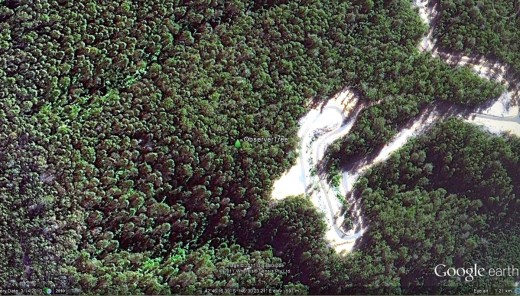 Close up image
(click photo to enlarge) Close up image
(click photo to enlarge)
.
.
Monday: Forestry Tasmania attacks the Styx Forest
.
On Monday 12th December 2011, State forest ‘nazi logger’, Forestry Tasmania, under the command of District Officer (Gauführer) Steve Whitely, rolled in its contracted ‘ecodeath-squad’ into the western end of the magnificent Styx Valley. The targeted forest area is situated at the base of Tasmania’s prominent and wild Mt Mueller on the border of the World Heritage Area. It is situated about 25 km west of the infamous logging town of Maydena.
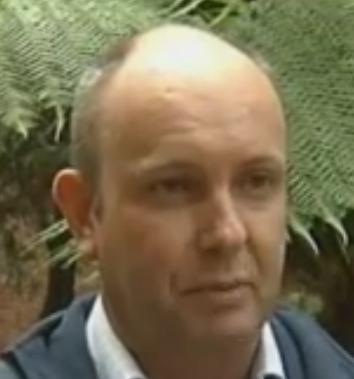 Directing the logging – Forestry Tasmania’s Steve Whiteley
[Source: Southern Cross Television, 20111214]
Directing the logging – Forestry Tasmania’s Steve Whiteley
[Source: Southern Cross Television, 20111214]
.
In true forest nazi style, Forestry Tasmania’s targeted forest area is branded as coupe ‘TN 044B‘.
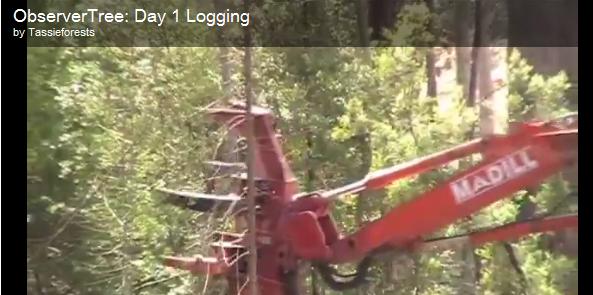 Logging Nazi in and destroying the Styx Valley Forest
Monday 12th December 2011, in direct breach of Prime Minister Gillard’s Forest Agreement. Logging Nazi in and destroying the Styx Valley Forest
Monday 12th December 2011, in direct breach of Prime Minister Gillard’s Forest Agreement.
.
This ‘Madill’ feller buncher was getting well stuck into the Styx Valley last Monday morning just below the Observer Tree. The hydraulic arm clamps onto the trunk of the tree while a cutting mechanism severs the tree at the stump. The machine then lifts the tree, lowers the tree into a horizontal position, and drops the tree on a bunch of logs piled on the ground. The industrial machinery has all the efficiency of a Nazi death factory.
.
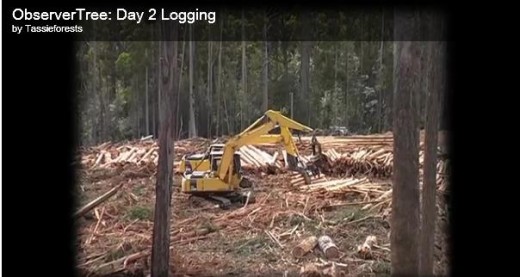
.
Foresty Tasmania is operating in direct contradiction of IGA Clauses 25 and 27. The coupes within the 430,000 ha of high conservation value forest are not to be logged under any condition. The IGA prescribes that relevant customers and contractors are to be granted compensation and million have been set aside for this purpose. Foresty Tasmania under Gauführer Steve Whitely is out of control. He is driving ecological apocalypse in Tasmania’s southern forests. He has become a Walter E. Kurtz.
 Walter E. Kurtz – unhinged, his methods unsound. Walter E. Kurtz – unhinged, his methods unsound.
.
Tags: Abdul Kalam, activist, Bill Kelty, El Grande, Forestry Tasmania, Gandalf, Google Earth, Inter Governmental Agreement, Julia Gillard, Lara Giddings, Maydena, Mount Mueller, nazi logger, Observer Tree, old growth forest, Still Wild Still Threatened, Styx Forest, Styx Valley, Tasmania, Tasmanian Betrayal, Tasmanian Forests Intergovernmental Agreement, The Observer Tree, Woodchipping Tasmania
Posted in Tasmania (AU), Threats from Deforestation, Threats from Weak Environmental Laws, Threats to Wild Tasmania | No Comments »
Add this post to Del.icio.us - Digg
Leave a Reply
You must be logged in to post a comment.
December 14th, 2011
Chinese-owned Yancoal’s Austar Coal Mine in the Hunter Valley, yesterday was found guilty by the Land and Environment Court in New South Wales of gross pollution of Bellbird Creek near Cessnock back in July 2010. Wastewater from the mine’s antiquated on-site septic system was allowed to seep into the creek, killing aquatic wildlife. But it has taken a year and a half for the court to finally prosecute the offence brought before it by the Environmental Protection Agency (EPA). Why?
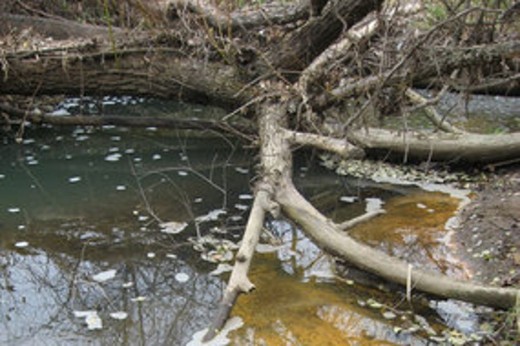 Septic pollution of Bellbird Creek
near Cessnock, Hunter Valley, New South Wales, Australia Septic pollution of Bellbird Creek
near Cessnock, Hunter Valley, New South Wales, Australia
.
Yancoal Australia’s parent company is Chinese-based Yanzhou Coal Mining Company, which is ultimately owned by the Shandong provincial government of China. Yanzhou promotes itself as being one of the safest and most productive users of Longwall Top Coal Caving technology (LTCC). Visit its website: ^http://www.yancoalaustralia.com.au/key-assets/austar-coal-mine/
Under its ‘Community Awareness’ section, subsidiary Yancoal Australia offers a scholarship program to assist undergraduate students choosing to pursue a career in the mining industry. How is this community awareness? Obviously there is a lack of environmental awareness. Mining profits are going back to China, at the Hunter Valley’s expense and at Bellbird’s expense.

The logo is very clear about the source and the impact
.
The court has fined Austar $115,000 for the pollution, including ordering Austar Coal Mine to pay $75,000 towards an environmental rehabilitation project and $42,000 in the EPA’s legal costs. This will be on top of Austar’s own legal costs. Austar has also been ordered to publish details of the offence in a local newspaper and industry magazine.
Chief Environmental Regulator for the Environment Protection Authority (EPA), Mark Gifford said “The wastewater contained detergent and effluent from bathhouse facilities located on the Austar site and caused large clumps of white foam up to 2 metres high to be washed downstream.
“The elevated levels of detergent, nutrients and faecal matter along approximately 2km of Bellbird Creek were toxic to aquatic life,” Mr Gifford said.
“This incident could have been prevented if Austar had an appropriate system in place to inspect, monitor and maintain the 90 year old onsite septic system.”
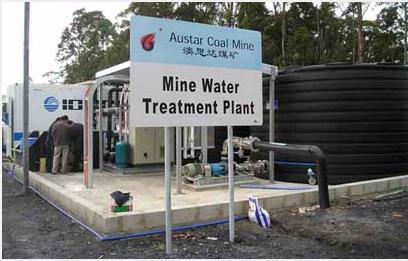
EPA Regional Manager Graham Clarke says it was not a minor incident.
“These are very large scale facilities, obviously bathhouse for the mine facilities they’re not just domestic systems and clearly large amounts of detergent and pollutants were coming from the system into the Bellbird Creek,” he said. “So it’s affected about two kilometres of the waterway at the time so these are not small incidents.”
.
But something is clearly amiss. For Austar’s mine pollution of detergent, nutrients and faecal matter to ‘extend two kilometres downstream‘ along Bellbird Creek and for ‘large clumps of white foam up to 2 metres high‘, this was not ‘seepage‘ – more like full-throttle pumping! Downstream also involves flowing through the village of Bellbird, effectively creating an open sewer through Bellbird.
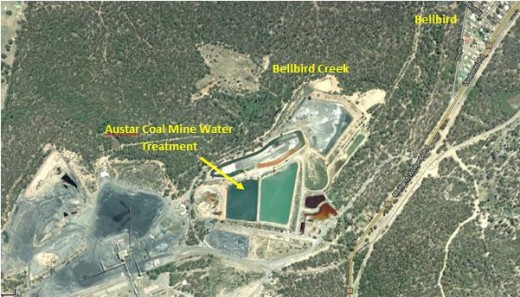
Following NSW Labor Government approval for Austar Coal Mine to begin longwall mining on its Hunter Valley lease, the company published its Community Information Sheet 4 dated June 2006, which on page 2 states:
‘Upgrades to the water management system to improve the recycling of mine water. Austar has been working closely with the Department of Environment and Conservation (EPA) to optimize water recycling and reduce dependency on external water supplies. The proposed improvements will include upgraded pumps, pipelines and water treatment facilities resulting in the Austar mine being almost self-sufficient in water supplies.’
.
The EPA has clearly been negligent in its monitoring, but then the EPA has no watchdog. To fine Yancoal $115,000 is a mere slap on the wrist. Yancoal recorded $1 billion in revenue in 2010, and sold 11 million tonnes of coal from its five operating mines on the east coast. So Yancoal has been fined 0.0115% of its annual revenue – petty cash! [Source: ‘Wesfarmers agrees to $300m Premier Coal deal with Yancoal’, by Nick Evans, Business Reporter, PerthNow, 20110928, ^http://www.perthnow.com.au/business/local-business/wesfarmers-agrees-to-300m-premier-coal-deal-with-yancoal/story-e6frg2s3-1226148929703]
.
- Where is the EPA’s Environmental Impact Statement made available to the local community?
- What has been the ecological cost?
- Where have the pollutants ended up?
- What is the risk to public health of Bellbird and downstream communities?
- What is the full cost of clean up to restore Bellbird Creek and its affected downstream waterways to a before pollution condition and to reinstate the ecological health of the waterways?
- Given Yancoal holds significant coal assets in Queensland and New South Wales, what monitoring is the EPA in those states doing, given that Yancoal has demonstrated that it cannot be trusted to protect the environment?
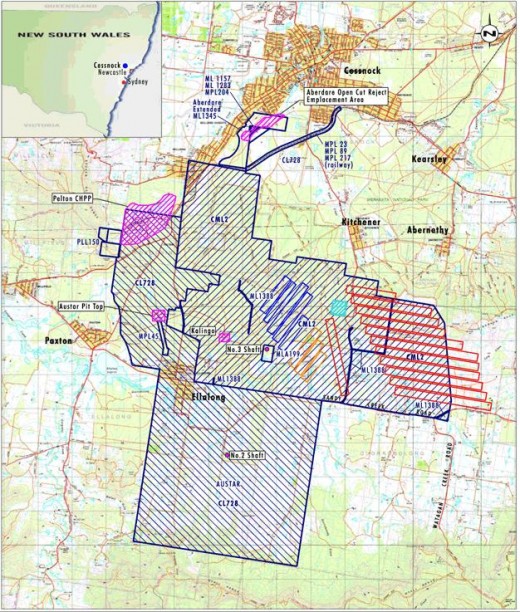 Yancoal’s Mining Leases in the Hunter Valley – set for underground long wall mining Yancoal’s Mining Leases in the Hunter Valley – set for underground long wall mining
.
[Sources: ‘Hunter Valley mine fined for polluting creek’, ABC, 20111213, ^http://www.abc.net.au/news/2011-12-13/hunter-valley-mine-fined-for-polluting-creek/3729336/?site=newcastle, ^http://www.environment.nsw.gov.au/media/DecMedia11121301.htm, http://www.abc.net.au/news/2011-12-14/mine-fine-for-polluting-creek/3729942]
.
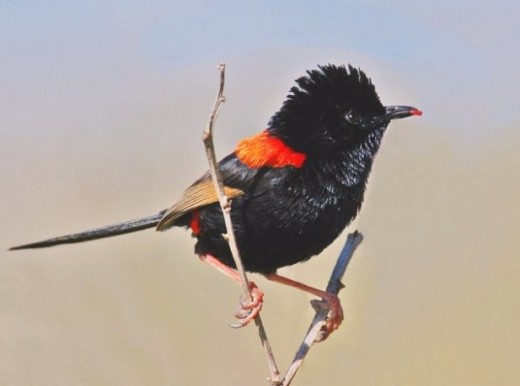 Red-backed Fairy-wren of the rivers of the Hunter Valley
. Red-backed Fairy-wren of the rivers of the Hunter Valley
.
The Red-backed Fairy-wren (Malurus melanocephalus) is a passerine bird in the Maluridae family. It is found only in Australia along the coasts of rivers. These rivers are the Hunter Valley in New South Wales and the Kimberley which is the northern portion of Western Australia.
[Source: ^ http://www.redorbit.com/education/reference_library/science_1/birds/2582912/redbacked_fairywren/index.html]
.
Tags: aquatic habitat, Austar Coal Mine, Austar fined, Bellbird Creek, detergent, EPA, Hunter Valley Coal Mining, Longwall Top Coal Caving (LTCC), mining pollution, nutrients and faecal matter, Red-backed Fairy-wren, septic system, Yancoal Australia, Yanzhou Coal Mining Company
Posted in Birds (Australian), Threats from Mining | No Comments »
Add this post to Del.icio.us - Digg
Leave a Reply
You must be logged in to post a comment.
|
|





































































That poacher who bowan arrowed that kangaroo should be prosocuted. That is so cruel and wrong how could you even let someone live after being so cruel to an animal who cant even really defend themselves against something like that, death penalty should be definately addmitted…